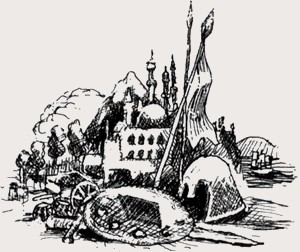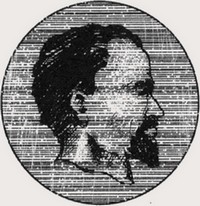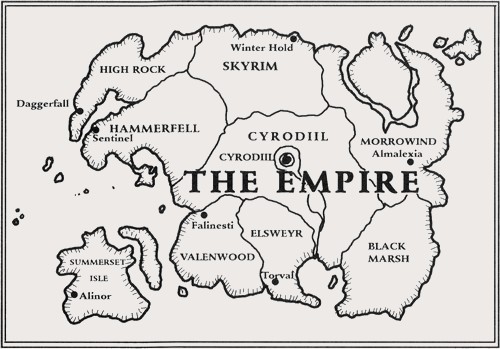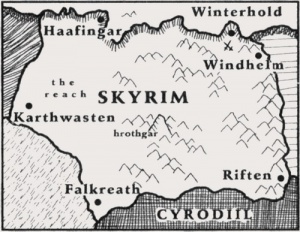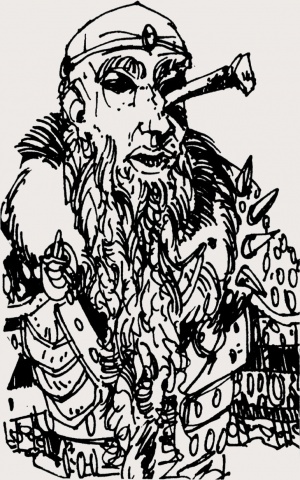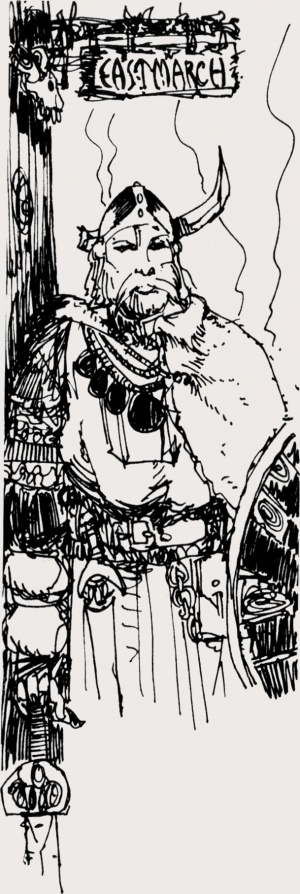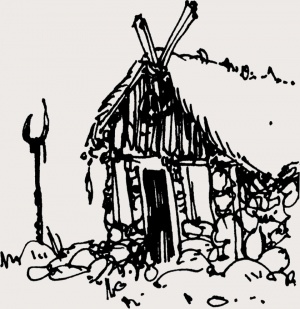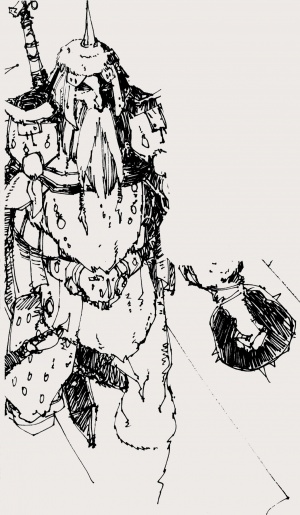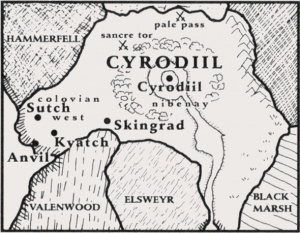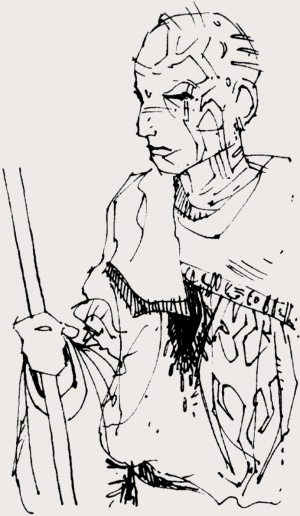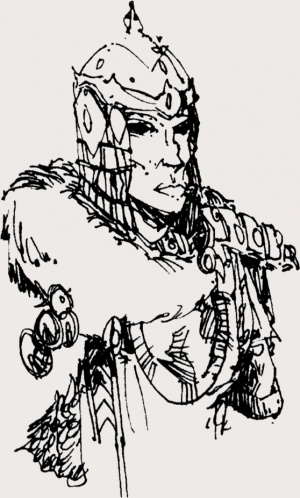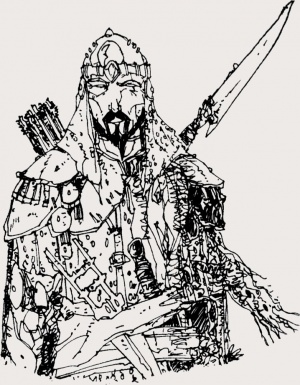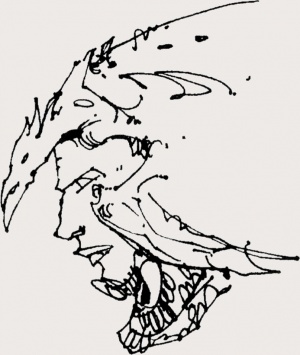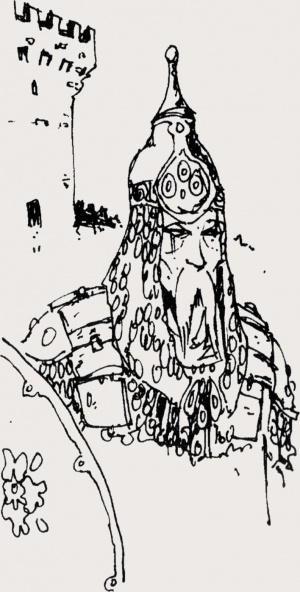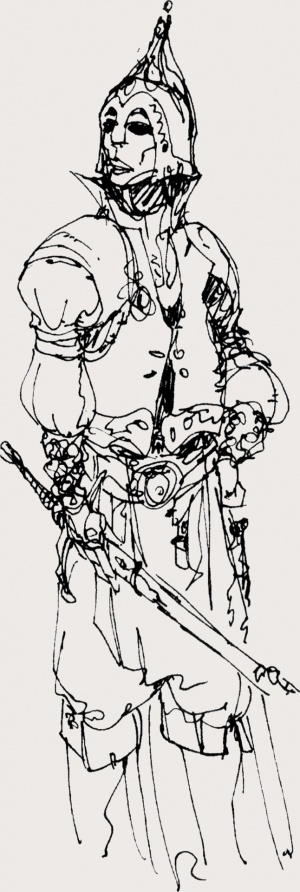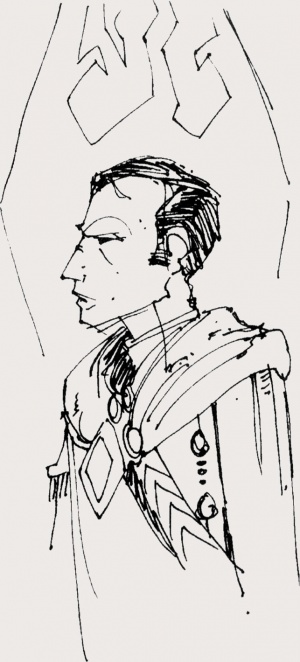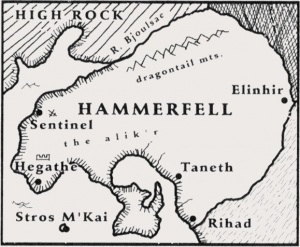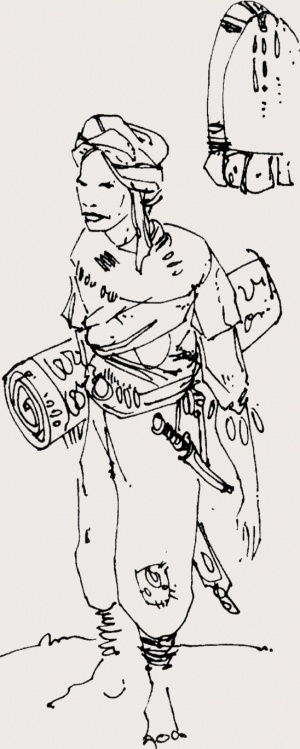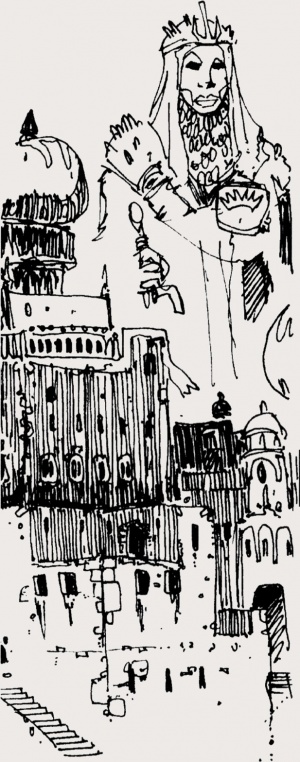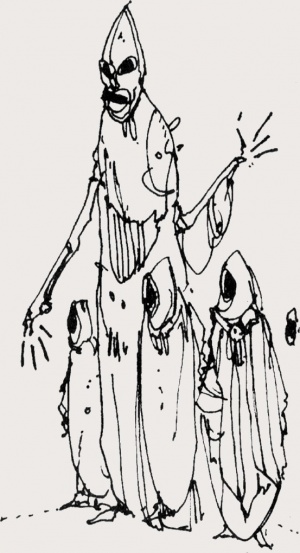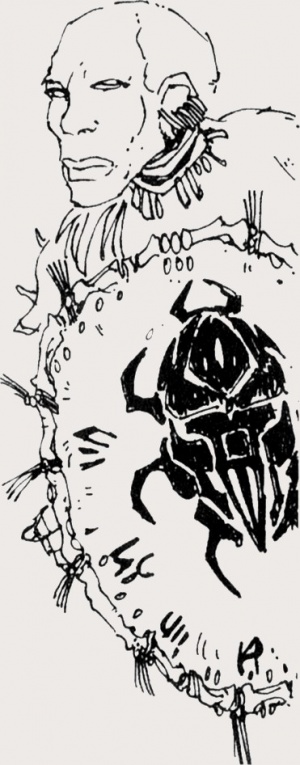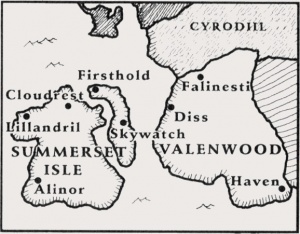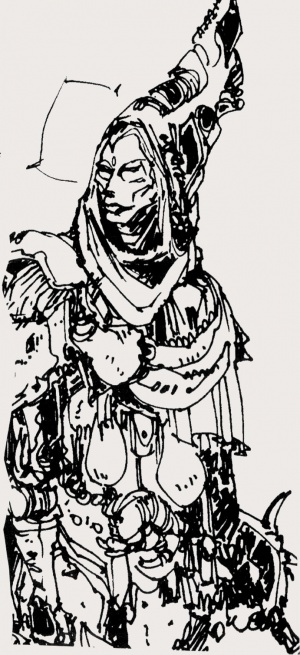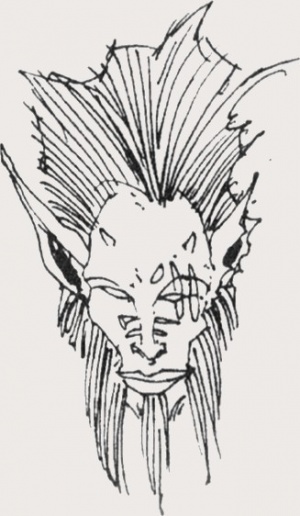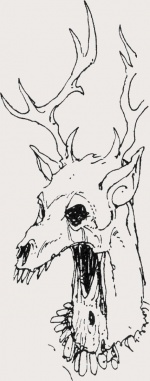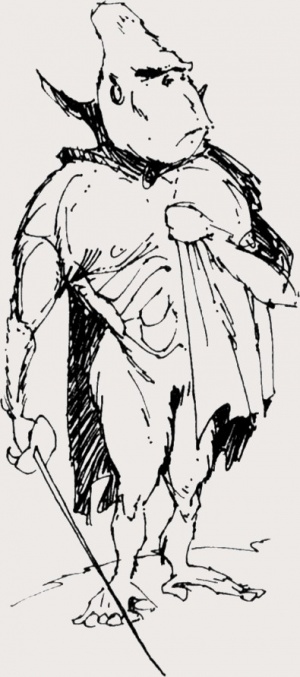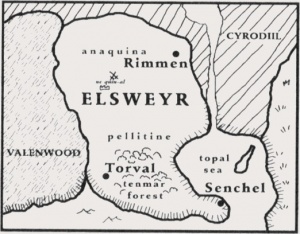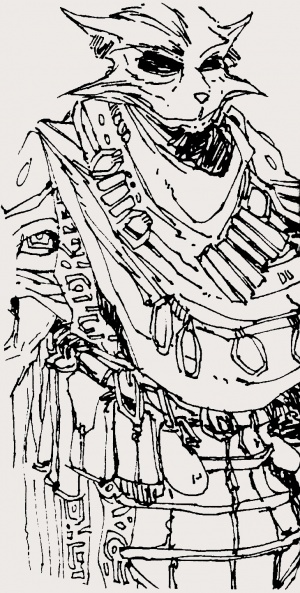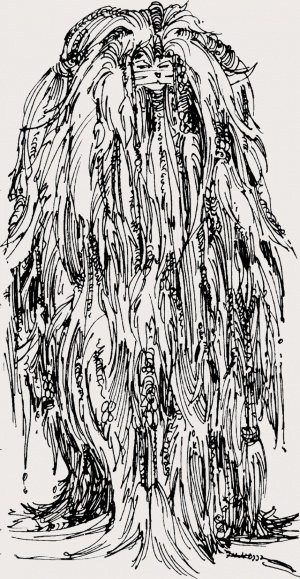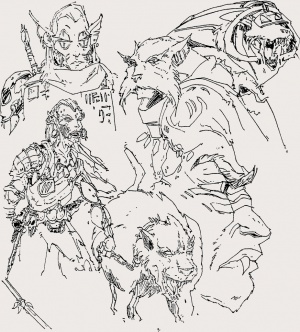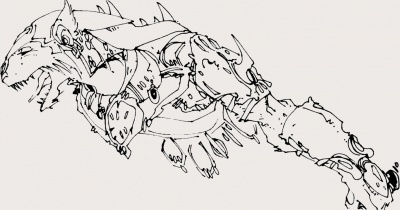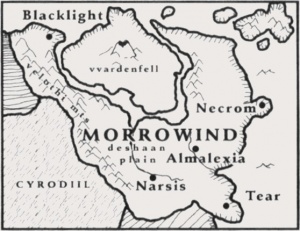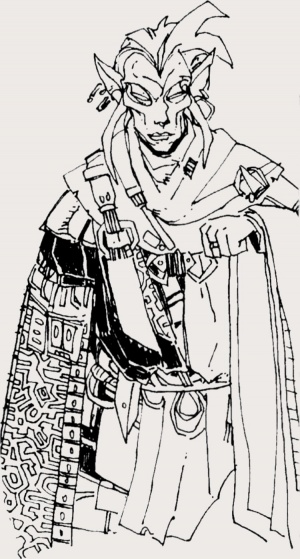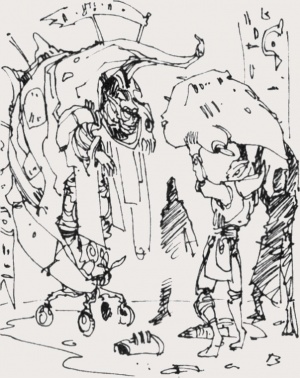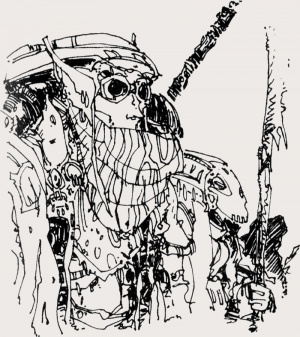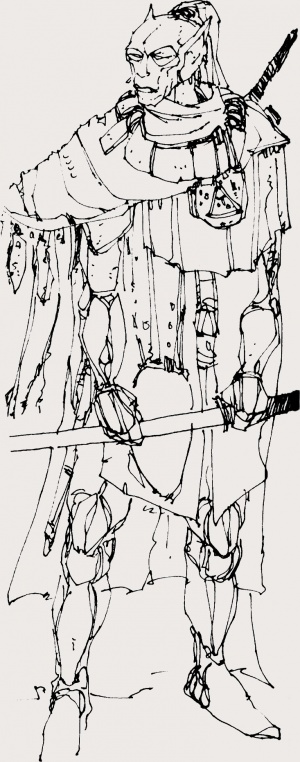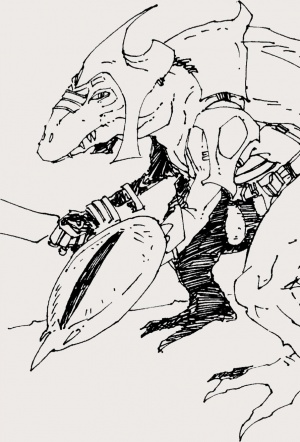Guide de poche de l'Empire, Première édition
Note : Ce livre est annoté par "YR", un elfe transmettant le présent guide à son oncle accompagné de la lettre suivante. Les annotations sont écrites comme ceci :
Mot commenté (Commentaire associé de YR).
Tout texte écrit de cette manière est également de YR. De même les crayonnés sont aussi faits par YR.
Dans ce texte on peut lire plusieurs fois "ÈC" ou "ère courante", Il s'agit de la seconde ère.
À mon plus respecté Oncle,
Avant de prendre mon poste en tant qu'attaché-militaire dans cette soi-disant Cité Impériale (un présage des intentions de ces humains), j'ai suivi votre conseil et j'ai fait un voyage à travers les Royaumes Extérieurs, à la fois dans cet Empire naissant et ces régions qu'il a encore à s'approprier ~
Ne vous méprenez pas, Talos (maintenant Tiber Septim, dans un Cyrodiilique resplendissant) a toujours l'ascendant. Je pense à présent que les oracles ont été mal interprétés ; Septim pourrait bien être le Fils de dragon comme prédit. Les Mers doivent finir par s'unir ou être consumés un à un. Père, béni soit le mystère numérique de son nom, était l'un des rares du Thaldmor à s'opposer à la politique de non-intervention d'Andel Crodo, qui si poursuivie mènera à la perte de toutes les Anciennes Races. Je comprends que ma situation ici présente est délibérément voulue comme une punition pour ne pas avoir suivi les traces de mon père, mais je vous exhorte de passer outre nos différends personnels et de faire suivre mes découvertes au Conseil dans son ensemble.
Je vous confie ce pamphlet, un échantillon de la propagande officielle du régime de Septim, annoté de mes propres observations qui bien que non tempérées par l'âge et la sagesse restent néanmoins utiles en tant qu'impressions d'un voyageur innocent.
~YR
L'EMPIRE
et ses environs
Une Description des Provinces et des
Diverses Coutumes de leurs habitants
et de plus une histoire utile des lieux d'intérêt
par la Nature de leur emplacement & d'Influence.
Dédié
À l'inébranlable Quête de Vérité et de Connaissance
de Sa Très Clairvoyante Majesté l'Empereur Tiber Septim.
Promulgué sous l'Autorité de la Société Géographique Impériale.
Descendant des Empereurs, Roi de la Terre et du Ciel,
Seigneur des Hôtes Étincelants,
Protecteur du Vassal, de l'Homme Libre et du Yeoman,
Garant de l'Équité et de la Justice,
Grande Bénédiction de Trônes et de Puissances,
Cynosure de Gloire Céleste,
Sa Grandeur Tiber Septim
| Les 8 Invocations et les 16 Blasphèmes tolérables.
À AKATOSH qui perché depuis l'Éternité fait le Jour. .noitaripsnI'l ed ecruoS al HAITÉOB À |
Bienvenue, Citoyen!
Avec l'aube d'une nouvelle ère devant nous, il est temps que nous fassions le point sur ce que nous avons fait et où nous en sommes, afin de mieux illuminer le chemin qui nous attend. Écrite en célébration de la Bataille de la Baie de Hunding, qui a marqué le retour de tous les royaumes humains sous le règne incontesté (cela reste à voir) de l'Empereur Cyrodiilique, cette brochure cherche à brièvement décrire les provinces actuelles de l'Empire et des régions alentour ; leurs histoires, leurs habitants et leurs situations actuelles. Nous nous sommes efforcés de satisfaire aussi bien nos délais que la précision et l'exhaustivité de ce guide; aussi si dans notre zèle à le placer dans les mains des citoyens intéressés de partout nous nous étions fourvoyés, nous demandons l'indulgence de nos lecteurs bienveillants.
L'Empire s'étend à travers Tamriel, le plus grand continent connu du Monde. Au Nord de Tamriel se trouve Atmora, d'où les Hommes du Monde sont venus. À l'Ouest repose Yokuda, la contrée perdue originaire des Rougegardes. À l'Est est Akavir, dont les armées ont envahi Tamriel dans l'ère précédente. Le Sud n'est que mystère et rumeurs d'une patrie Elfique perdue (Ainsi, même les humains ont entendu parler du Vieux Ehlnofey).
Tamriel est elle-même composée de huit régions majeures : Bordeciel, Cyrodiil, Hauteroche, le Domaine Aldmeri de l'Archipel de l'Automne et du Val-Boisé, Lenclume, Morrowind et la Confédération d'Elsweyr. Certaines d'entres elles, comme Morrowind ou Bordeciel, ont historiquement été unifiées en royaumes; d'autres, comme Hauteroche ou Elsweyr sont de lâches regroupements de plusieurs royaumes, fiefs, confédérations de villages, et ainsi de suite, unis sous une race ou une culture dominante. À son zénith, le Second Empire a formellement mis de l'ordre dans ces groupes disparates pour donner les Provinces Impériales, administrées par des gouverneurs provinciaux, directement envoyés depuis Cyrodiil ou choisis dans la population locale. (Morrowind est une exception notable, n'ayant jamais été conquis par l'Empire Cyrodiilique originel, et, par conséquent, échappant à l'investiture en tant que Province Impériale.) Avec la chute de l'Empire Cyrodiilique, le contrôle est retourné aux mains des dirigeants de chaque province, aboutissant à des siècles de chaos du fait que beaucoup de provinces régressèrent en royaumes indépendants et en minuscules mini-états. À présent, les royaumes humains ont fort heureusement été reconquis par le Troisième Empire de Tiber Septim et peuvent à nouveau porter le fier titre de Provinces Impériales (Une arrogance à couper le souffle!).
Le Domaine Aldmeri, la Confédération d'Elsweyr et Morrowind n'ont pas encore rejoint l'Empire, mais sont décrits dans ce livre dans le but de satisfaire l'édification de l'érudit, la fascination du citoyen de tous les jours, et la préparation du soldat. Le Troisième Empire est toujours dans sa prime jeunesse, et qui peut prédire quels nouveaux horizons viendront à la rencontre de l'aube sous la Bannière du Diamant Rouge?
Certaines régions échappent à la classification provinciale du fait de leurs civilisations primitives et de leurs habitants hommes-bêtes. Dans leur ensemble, ces 'états' hommes-bêtes sont connus sous le nom de Régions Sauvages, et pourraient ou non être d'un quelconque intérêt à l'Empereur. Elles sont seulement décrites ici à l'intention des plus intrépides voyageurs et afin d'illuminer plus encore les hauts-faits de la Civilisation par contraste avec ces recoins arriérés de Tamriel.
À présent, citoyen, nous vous implorons de bien vouloir considérer notre modeste étude des domaines de l'Empire. Si elle vous divertit et vous instruit, que cela ne se reflète pas sur les humbles travaux de ce scribe, mais sur la gracieuse bénévolence de notre Empereur bien aimé, dont le seul nom a le goût de l'ambroisie sur nos langues, et qui dans sa sagesse a ordonné que cette étude soit créée et distribuée parmi nos chers et sages gens de Tamriel, afin qu'ils comprennent mieux encore les gloires et défis de ces Royaumes et Domaines, et qu'ils se rendent compte mieux encore des grands fardeaux du commandement qu'il porte en nos noms avec tant de courage.
Une remarque sur les désignations Elfiques: Les Elfes dans leur ensemble sont parfois appelés les 'Aldmeri', ou les ' Anciennes Races'. Leurs pedigrées individuels (Dangereux racisme, aucun compromis ne serait être possible, tout comme avec Reman.) sont de même désignés aussi bien par leur noms humains que leur noms Aldmeris; ainsi, les Hauts-Elfes sont les 'Altmer', les Elfes Noirs les 'Dunmer', les Elfes des Bois les 'Bosmer', etc, etc... Le terme 'Mer' est également utilisé pour indiquer un elfe. Les mots utilisés pour désigner un membre Elfique d'une profession ou d'un métier peuvent ainsi simplement être 'artisanmer', par exemple, ou 'noblemer'.
Bordeciel, également connue sous le nom de Vieux Royaume ou la Patrie, fut la première région de Tamriel colonisée par les humains : les hardis, braves, belliqueux Nordiques, dont les descendants occupent encore cette terre rude, et, bien qu'ils soient quelque peu amoindris en regard de la renommée légendaire de leurs aïeux, les Nordiques de sang pur surpassent incontestablement les races mêlées dans tous les domaines virils.
Le moment exact où les Nordiques ont pour la première fois traversé la Mer des Fantômes depuis Atmora, leur terre natale, est inconnu. D'après le Chant du Retour, Ysgramor et sa famille accostèrent d'abord Tamriel par la Tête de Hsaarik, à la pointe Nord du Cap Brisé de Bordeciel, fuyant la guerre civile d'Atmora (à cette époque plus ardente qu'elle ne l'est à présent, puisqu'elle semble avoir impliqué une part considérable de la population). Ces premiers colons nommèrent le pays "Mereth", en l'honneur des Elfes qui parcouraient les terres sauvages qui recouvraient alors tout Tamriel. Pendant un certain temps, les relations entre Humains et Elfes furent harmonieuses, et les Nordiques prospérèrent en ces nouvelles terres, conviant leurs semblables du Nord à venir construire la ville de Saarthal, site récemment localisé par les archéologues Impériaux à proximité de Fortdhiver. Mais les Elfes virent que cette jeune race pleine de vie surpasserait sous peu leur culture stagnante (!) si rien ne les bridait, aussi déferlèrent-ils sur les Nordiques sans méfiance au cours de la tristement célèbre Nuit des Larmes ; Saarthal fut brûlée, et seuls Ysgramor et deux de ses fils (les provocations et blasphèmes d'Ysgramor ont, bien sûr, été oubliés depuis longtemps ~) se sortirent de ce carnage et s'enfuirent en Atmora. Les Elfes, cependant, avaient compté sans l'esprit indomptable des Nordiques. Réunissant ses légendaires Cinq Cents Compagnons (dont les noms sont encore de nos jours récités à chaque trentième jour du mois de Clairciel lors de la Fête des Morts, en Vendeaume), Ysgramor revint en Tamriel assoiffé de vengeance, chassant les Elfes hors de Bordeciel et posant les bases du premier Empire humain.
Il est possible que les exploits du quasi légendaire Ysgramor aient assimilé les règnes de plusieurs Rois Nordiques, car les Elfes n'ont fini par être chassés des frontières actuelles de Bordeciel que lors du règne du Roi Harald, le trentième descendant de la lignée d'Ysgramor, à l'aube de l'histoire connue. On se souvient également du Roi Harald comme le premier roi à renoncer à toute possession d'Atmora ; les Nordiques de Bordeciel devenant alors un peuple à part entière, au visage fermement tourné en direction de leur destinée, la conquête des vastes nouvelles terres de Tamriel. En effet, l'histoire des Nordiques est celle des humains de Tamriel ; toutes les races d'humains, à l'exception des Rougegardes, descendent des Nordiques, bien qu'il soit vrai qu'un peu de sang des Peuples Anciens circule dans les veines de certains d'entre eux.
| Les Elfes des Neiges Les Nordiques imputent quasiment tous les revers de fortune ou désastres aux manigances des Falmers, ou Elfes des Neiges, qu'il s'agisse de mauvaises récoltes, d'un mouton manquant, ou d'un voyageur perdu en traversant un col élevé. Les croyances populaires affirment que ces êtres mythiques seraient les descendants des peuples Elfiques originels et qu'ils vivent dans les montagnes isolées qui recouvrent Bordeciel. Cependant, il n'existe aucune preuve tangible que cette communauté Elfique survive en dehors de l'imagination des villageois supersticieux. Mon oncle, j'ai vu des signes pouvant être des runes falmers, mais rien n'est certain. Si certains ont survécu, ils sont méfiants et reclus. |
Le roi Vrage le Doué lança l'expansion qui conduisit à la formation du Premier Empire des Nordiques. En l'espace de cinquante ans, Bordeciel règna sur tout le Nord de Tamriel, y compris la majeure partie de l'Hauteroche actuelle, une bonne partie de la Vallée du Nibenay, et la totalité de Morrowind. La conquête de Morrowind fut l'un des affrontements héroïques de la Première Ere, duquel s'ensuivit de nombreux conflits entre Nordiques et Elfes Noirs dans les collines et les bosquets de ce terrible royaume, encore rappelés par les chansons des bardes dans les tavernes de Bordeciel. Le système de succession au cours du Premier Empire est digne d'être remarqué, car il finit par provoquer la chute de l'Empire. Au début du Premier Empire, Bordeciel était déjà divisée en Conquêtes, gouvernées en un patchwork de chefs de clan, rois et conseils (ou assemblées), tous ayant juré allégeance au Roi de Bordeciel. Pendant le règne exceptionnellement long du Roi Harald, qui mourut à l'âge de 108 ans et survécut à tous ses fils sauf trois, une Assemblée fut créée, réunissant des représentants de chaque Conquête, afin de choisir qui sera le Roi suivant parmi les membres habilités de la famille royale. Au fil des ans, l'Assemblée devint permanente et acquit davantage de pouvoir ; au cours du règne du Roi Borgas, le dernier descendant de la dynastie d'Ysgramor, l'Assemblée devint partisane et inefficace. Lors du meurtre (joli coup) du Roi Borgas des suites de la Chasse Hivernale (cf. "Domaine Aldmeri - Val-Boisé"), l'incapacité de l'Assemblée à nommer l'évident et compétent Jarl Hanse de Fortdhiver entraîna la catastrophique Guerre de Succession de Bordeciel, au cours de laquelle Bordeciel perdit le contrôle de ses territoires de Hauteroche, Morrowind et Cyrodiil, pour ne jamais le regagner. La Guerre finit par arriver à son terme en 1E420 avec le Pacte des Chefs ; à partir de cet instant, l'Assemblée ne fut plus convoquée que lorsqu'un Roi mourait sans laisser de descendant direct, et remplit son rôle plus limité admirablement. Elle n'a été convoquée qu'à trois reprises au cours de ce millénaire, et la succession de Bordeciel ne fut plus jamais disputée sur un champ de bataille.
Les terres de Bordeciel sont les plus accidentées du continent, comprenant quatre des cinq pics les plus élevés de Tamriel (cf. "Lieux d'Intérêt : La Gorge du Monde"). Ce n'est qu'à l'Ouest que les montagnes font place aux canyons et aux mesas du Reach, de loin la partie la plus cosmopolite des Conquêtes de Bordeciel, les Nordiques de sang pur n'occupant que la majeure partie des espaces vides d'après le dernier recensement Impérial. Le reste de Bordeciel est vertical : de hautes crêtes du Nord-Ouest au Sud-Est serpentant le long des chaînes de montagnes, de profondes fissures, d'étroites vallées où réside la majeure partie de la population. Le long des berges de la rivière traversant les vallées, les rudes fermiers Nordiques font pousser des cultures variées ; le blé foisonne au fond relativement tempéré de la rivière, alors que seuls les buissons de Symphorine parviennent à survivre au niveau de la limite des arbres. Les premières colonies Nordiques furent en général étbalies sur des promontoires rocheux surplombant une vallée fluviale ; nombre de ces villages survivent encore dans les Conquêtes plus isolées, surtout le long de la frontière avec Morrowind. Cependant, dans la majeure partie de Bordeciel, cette disposition fut jugée superflue vers la moitié de la première ère, aussi la plupart des villes se trouve-t-elle de nos jours dans les vallées, parfois surplombées par les ruines pittoresques de l'ancien village.
| "Les Langues" Les Nordiques pratiquent depuis longtemps une forme spirituelle de magie connue sous le nom de "Le Chemin de la Voie", essentiellement basée sur leur vénération du Vent sous la personnification de Kynareth. Les Nordiques se considèrent eux-mêmes comme les enfants du ciel, et le souffle et la voix d'un Nordique est son essence vitale. Par l'utilisation de la Voix, la puissance vitale d'un Nordique peut être articulée en un thu'um, ou cri. Les cris peuvent être utilisés pour aiguiser une lame ou pour toucher des ennemis à distance. Les maîtres de la Voix sont connus sous le nom de Langues, et leur pouvoir est légendaire. Ils peuvent appeler une personne spécifique à des kilomètres de distance, et se déplacer d'un cri, apparaissant à son point d'arrivée. Les Langues les plus puissants ne peuvent parler sans provoquer des catastrophes. Ils doivent vivre bâillonnés, et communiquer via un langage des signes et en écrivant des runes. Durant la Conquête de Morrowind et la fondation du Premier Empire, les grands chefs de guerre Nordiques - Derek le Grand, Jorg Helmbolg, Hoag Merkiller - étaient tous des Langues. Quand ils attaquaient une ville, ils n'avaient pas besoin d'engin de siège ; les Langues se réunissaient en formant un angle en face de la porte, et prenaient une grande inspiration. Quand le meneur la laissait ressortir en un thu'um, les portes étaient soufflées, et les guerriers se ruaient dans la ville. Tels étaient les hommes qui forgèrent le Premier Empire. Mais, malheureusement pour les Nordiques, l'un des plus puissants de tous les Langues, Jurgen Windcaller (ou Le Paisible, nom sous lequel il est plus connu à présent), se convertit à des principes pacifistes qui dénonçaient l'usage de la Voix à des fins guerrières. Sa philosophie prévalut, essentiellement grâce à son incontestable maîtrise de la Voix -- sa victoire fut scellée lors d'une confrontation légendaire, au cours de laquelle Le Paisible aurait "avalé les Cris" de dix-sept Langues activistes pendant trois jours, jusqu'à ce que ses adversaires s'effondrent tous de fatigue (et devinrent alors ses disciples). A présent, le plus ancien et puissant des Langues s'est retiré dans les plus hauts sommets afin de mener une vie de contemplation, et n'a parlé qu'une seule fois de mémoire d'homme, pour annoncer la destinée du jeune Tiber Septim (telle qu'elle est racontée en Cyrodiil). En remerciement, l'Empereur a récemment ouvert une nouvelle Académie Impériale de la Voix en Markarth, vouée à ramener le Chemin de la Voix à l'ancien et honorable art de la guerre. Il est donc possible que les impressionnants exploits des anciens héros Nordiques soient sous peu égalés ou même surpassés sur un champ de bataille. La nouvelle académie de Septim est composée de plumitifs et de charlatans -- on dit que le soi-disant Grand Maître gagnait sa vie en jouant les baladins à Vendeaume -- les étudiants sont les descendants des familles Nordiques les plus obséquieuses, qui espèrent gagner les faveurs du Nouvel Ordre de Tiber Septim ~ |
Les Nordiques sont les maîtres du bois ; de nombreux bâtiments en bois construits par les premiers colons, il y a environ 3.000 ans, sont encore utilisés de nos jours. Un bon exemple de l'ingénierie militaire Nordique peut être vue à Old Fort, un des bastions royaux construits au cours du Premier Empire afin de surveiller la frontière Sud. D'imposants murs d'immenses blocs de porphyre s'assemblent sans trace visible de mortier, comme s'ils avaient été construits par les mythiques Elfoneys plutôt que par des hommes.
Les neuf Conquêtes présentent un aspect de diversité par leurs peuples, gouvernements et commerces. Le Reach pourrait être pris pour un petit royaume de Hauteroche ; il est peuplé de Brétons, Rougegardes, Cyrodiils, Elfes de tous poils et même de quelques khajiits égarés. Les Captures Nord et Ouest -- Fortdhiver, Eastmarch, Rift et le Pale, connus sous sous le noms de "Anciennes Conquêtes" -- restent plus isolées, du fait de la géographie et par choix, et les Nordiques qui y résident sont restés fidèles aux anciennes coutumes. Les étrangers y sont rares, habituellement la visite annuelle d'un colporteur itinérant. Les jeunes hommes partent pour des semaines dans les hauteurs à la fin de l'hiver, pour chasser les spectres de glace et ainsi obtenir le statut de citoyen à part entière (une pratique louable qui pourrait service d'exemple aux régions plus "civilisées" de l'Empire). Là-bas, le peuple continue aussi à révérer ses chefs héréditaires, alors que les autres Conquêtes sont depuis longtemps gouvernées par des assemblées élues. C'est une chance pour Bordeciel et l'Empire des Septim que le peuple des Anciennes Conquêtes ait préservé les traditions de leurs aïeux. Bordeciel a longtemps été latente, sommeillant à travers les millénaires pendant que des conquérants parcouraient Tamriel. Mais à présent, un fils de Bordeciel (une revendication sujette à controverses ~) porte à nouveau le destin du monde entre ses mains. Si Bordeciel est en train de s'éveiller, sa renaissance sera guidée par ces Nordiques qui demeurent son meilleur espoir d'un futur.
J'ai trouvé nombre de ces villages montagnards presque entièrement désertés par les jeunes hommes, qui se sont joints à l'armée de Septim, séduits par les promesses de fortune et de gloire ; les anciens des villages ont peu d'espoir de voir un jour revenir leurs fils.
Lieux d'Intérêt :
Haafingar (Solitude)
Ville natale de la célèbre Ecole des Bardes, Haafingar est aussi un des principaux ports de Bordeciel, et on peut voir sur ses quais des navires provenant de toute la côte, transportant du bois et des morues salées pour les marchés de Refuge, de l'Ouest d'Anvil, et de Senchelle. Fondée durant la longue période d'accointance Alessienne de Bordeciel, l'Ecole des Bardes continue à faire étalage d'hérésies, et ses étudiants sont de fameux buveurs, dignes du métier qu'ils ont choisi. Chaque année, les étudiants envahissent la place du marché pour une semaine de réjouissances, à l'apogée de laquelle est brûlée l'effigie du "Roi Olaf", probablement un prétendant à présent oublié de l'époque de la Guerre de Succession. Les diplômés n'ont aucun mal à trouver un emploi dans les maisons nobles de Tamriel, y compris la désormais restaurée Cour Impériale de Cyrodiil, mais nombre d'entre eux choisissent encore de suivre les traces errantes d'anciens étudiants illustres tels que Callisos et Morachellis.
Vendeaume
Ancienne capitale du Premier Empire, le palais de la dynastie d'Ysgramor domine toujours le centre de la Vieille Ville. Vendeaume fut mise à sac au cours de la Guerre de Succession, puis par l'armée Akaviroise d'Ada'Soon Dir-Kamal ; le Palais des Rois est l'un des rares bâtiments du Premier Empire à avoir perduré. De nos jours, Vendeaume reste la seule grande ville de la décidément rurale Conquête d'Eastmarch, et sert de base aux troupes Impériales qui gardent le Col de Dunmeth de Morrowind.
La Gorge du Monde
Il s'agit de la plus haute montagne de Bordeciel, et la plus haute de Tamriel en mettant à part Vvardenfell, en Morrowind. Les Nordiques croient que les hommes ont été créés sur cette montagne lorsque le ciel souffla sur les terres. Ainsi, le Chant du Retour fait référence non seulement au retour d'Ysgramor sur Tamriel après la destruction de Saarthal, mais aussi au retour des Nordiques à ce qu'ils croient être leur terre natale. Des pélerins traversent Bordeciel pour gravir les Sept Cents Marches du Haut Hrothgar, où repose le plus ancien et honoré des Barbes Grises (~Enfin, des humains dignes de respect. J'ai rencontré un ancien Barbe Grise qui pouvait presque me parler d'égal à égal.~ jusqu'à présent ma seule expérience de ce genre avec les humains_) dans le silence absolu, dans leur quête de devenir toujours plus sensibles à la voix du ciel.
Cyrodiil, Dragon Empire, Starry Heart of Nirn, and Seat of Sundered Kings... Indeed, if the history of the Nords is the history of humans on Tamriel, then Cyrodiil is the throne from which they will decide their destiny. It is the largest region of the continent, and most is endless jungle. Its center, the grassland of the Nibenay Valley, is enclosed by an equatorial rain forest and broken up by rivers. As one travels south along these rivers, the more subtropical it becomes, until finally the land gives way to the swamps of Argonia and the placid waters of the Topal Bay. The elevation rises gradually to the west and sharply to the north. Between its western coast and its central valley there are all manner of deciduous forest and mangroves, becoming sparser towards the ocean. The western coast is a wet-dry area, and from Rihad border to Anvil to the northernmost Valenwood villages forest fires are common in summer. There are a few major roads to the west, river paths to the north, and even a canopy tunnel to the Velothi Mountains, but most of Cyrodiil is a river-based society surrounded by jungle.
| Alessian Order This monotheistic religion was once very popular, but today only remnants of its faith remain. It started in the coastal jungle of what is now the Colovian west, where a prophet named Marukh, who had spoken to the "Enlightened One," Saint Alessia, began to question the validity of Elven rule. These sentiments led to an increasingly abstract and unknowable depiction of a Single God. The Alessians were wise enough to realize that they had to incorporate the ancient polytheistic elements into their new religion for it to find a wide acceptance. The divine aspects worshipped by the various humans and Aldmeri were recognizable in the guise of the myriad saints and spirits of the evolving Alessian canon. It wasn't long before the Order was the authority on every religion in Tamriel, and their power grew to earthshaking proportions. Nearly a third of the First Era passed under their theocratic rule. When its priesthood had become too widespread to support itself, the Order began to fight among itself. With the severance of the territories of West Cyrodiil from the Empire, too much money and land had been lost. The War of Righteousness broke out, and the Order which had almost ruled the world undid itself in a ten year span. |
Cyrodilic history truly begins by the middle of the Alessian Reformation (see sidebar, Alessian Order), when civilization and cultivation had allowed the region to emerge as a discernible Tamrielic power. Its culture and military strength centered in the sacred Nibenay Valley, a grassland expanse with a vast lake at its heart. Several small islands rose from this lake, and the capital city sprawled across them, crisscrossed with bridges and gondola ferries. Rivers connected the city-state to both its profitable outlying territories and the friendly inland ports of Skyrim and Pellitine. Rice and textiles were its main exports, along with more esoteric treasure-goods, such as hide armor, moon-sugar, and ancestor-silk. The sheer size of Cyrodiil's physical theater, and frequent intervals of Elven tyranny, made its unification as a whole a slow and oft-interrupted process. At the height of Alessian influence, its western arm enjoyed a brief autonomy as the Colovian Estates, a demarcation that still colors an outsider's view of the Empire today; often, Cyrodiil has two faces, East and West, and any discussion of its later social history must first be tempered with a summary of this early divergence.
Traditionally, the East is regarded as the region's soul: magnanimous, tolerant, and administrative. It was in the rain forests of the Nibenay Valley that the original Cyro-Nordic tribes, the Nibenese, learned a self-reliance that separated them culturally and economically from Skyrim. The Elven harassment of the First Empire gave rise to an elite form of support troop for the Valley armies, the battlemage (Our old students forget themselves). By the time the Alessian Doctrines filtered down from the north along the river trade ways, these mages had become the ruling aristocracy. They were quickly superseded by the Alessian priesthood, whose inexplicably charismatic religion found purchase in the lower classes. The traditional Nordic pantheon of Eight Divines was replaced by a baroque veneration of ancestor spirits and god-animals, practices encouraged by the mutable-yet-monotheistic doctrines of the Alessian faith. The doctrines eventually codified nearly every aspect of Eastern culture. Restrictions against certain kinds of meat-eating, coupled with the sentiments of the blossoming animal cults, soon made agriculture and husbandry nearly impossible. Thus, many of the Eastern Cyrodiils were forced to become merchants, which, over time, allowed the Nibenay Valley to become the wealthiest city-state in the region. Yet, under Alessian rule, no matter how rich or powerful the merchant class became it was still a tenanted citizenry, and the tithes they were forced to pay the priesthood were constant reminders of the state's true masters.
The West is respected as Cyrodiil's iron hand: firm, unwavering, and ever-vigilant. The Cyro-Nords that settled it had relinquished the fertile Nibenay Valley long ago, determined to conquer the frontier. Their primitive ferocity was disinclined to magic or the need for industry, preferring bloody engagement and plunder instead. After they had captured the Nedic port-cities of the Strident coast, the Westerners embarked on a mastery of the sea. Their earliest voyages took them as far as the Iliac Bay and the Cape of the Blue Divide, whose ports they annually raided until the (then) superior Yokudan navies arrived, ca. 1E810. By the time of the Alessian Reformation, the Westerners were firmly in a position, both geographically and socially, to resist its doctrines. Hammerfell, its northern border state, was now protected by its own holy-avenging order, the Ra Gada, whose bloody intolerance for foreigners acted as West Cyrodiil's buffer against the Alessian priesthood. The pantheon of Eight Divines, therefore, survived unchecked in Western Cyrodiil, and relations with the increasingly Alessian East became strained. Ultimately, the West isolated itself from the theocratic hegemony of the Nibenay Valley, establishing an autonomous government, the Colovian Estates.
Things persisted in this vein until the Thrassian Plague of 1E2200 (see Free Regions- Thras), which decimated more than half of Tamriel's population, particularly the western coastlands closest to Thras. After Bendu Olo, the Colovian king of Anvil, led the All Flags Navy to victory over the slugfolk of Thras, the glory of the Cyrodilic people became known throughout the world. The Colovian Estates began to overshadow the richer, more populous East then, which eventually lead to the War of Righteousness that ended Alessian rule.
| The Second Empire The Second Empire is divided into two stages: the Reman Dynasty and the Akaviri Potentate. As mentioned in the text, after the Akaviri raiders had been defeated, Reman recruited many of them into his service. Later Cyrodiils traditionally kept a House Guard of Akaviri, and the Emperor's chief advisor, the Potentate, was usually of Akaviri descent. Other Akaviri slaves played a significant part in establishing the administrative structures of the Second Empire, as well as in the training of its military. The restructured Imperial legions, which learned an unparalleled measure of coherence, logistics, and discipline from the Akaviri, began to easily overwhelm the other regional armies; soon every region in Tamriel belonged to Cyrodiil except for Morrowind. After the assassination of Reman's last heir by the Dark Elven Morag Tong during the disastrous Four Score War, control of the Empire reverted to the Akaviri Potentate. They have left a visible mark on the Empire of today. The high crafts of daikatanas and dragonscale armor came from Akavir, as did the banners and military dress of Septim's shock troops, the Blades. The Red Dragons that have come to represent the Empire and the Imperial City were originally Akaviri war mounts. Akaviri surnames are rare and prized possessions among the Cyrodilic citizenry of today, and there are trace facial features of the Akaviri in many distinguished Cyrodilic families. Some colonies of "true Akaviri" still exist in both the Empire and its border regions, but they are named so only for their practices and customs than for the purity of their blood. |
Control of the Nibenay Valley reverted to a mercantile-magocracy that was still far too arcane for Western tastes to entertain a reunification of Cyrodiil. Four hundred years would pass before that would happen, when Reman I, another proud son of the West, rallied the Valley's army to join his own and fight the Akaviri Invasion of 1E2703. The Cyrodilic forces engaged the Akaviri in every region of the north, eliciting their surrender at last in the Pale Pass of Skyrim. By war's end, the Cyrodiils found themselves not only united as a nation, but, too, responsible for the further protection of the northern human kingdoms at large. When the Elves of the Summerset Isles took umbrage at what they perceived as a renewed human imperialism, Reman was forced to prove them right. In order to prevent the Elves from attacking(Ha!) the already weakened northern kingdoms, he offered the captive Akaviri Horde amnesty in his future dominions if they would serve as the nucleus of the Army of the Second Empire of Men. Reman's own dynasty lasted for two hundred years, and in that span it conquered all the kingdoms of Tamriel except for Morrowind. Indeed, the Dark Elven Morag Tong were the doom of Reman's heirs, and the death of the last true Cyrodilic Emperor heralded the beginning of the Common Era.
| The Song of Tiber Septim From the Odes: "He was born in Atmora as Talos, 'Stormcrown' in the language of the ancient Ehlnofey, and it was from that shore he sailed. He spent his youth in Skyrim among the Nords. There he learned much from the Tongues and their chieftains and their ways of war. At twenty he led the invasion of Old Hrol'dan, taking it back from the Witchmen of High Rock and their kinsmen. "Soon the Greybeards made known that they were restless. Already the storms had begun from their murmurs. The Greybeards were going to Speak. The surrounding villages were abandoned as the people fled the coming blast. "The villagers warned Talos to turn back, for he was marching to the mountain where the Greybeards dwelt. "Inside he went, and on seeing him they removed their gags. When they spoke his name the World shook. "The Tongues of Skyrim told the son of Atmora that he had come to rule Tamriel and that he must travel south to do so. "And it is true that Talos did come to Cyrodiil shortly after the Battle of Old Hrol'dan. "And it is true that a great storm preceded his arrival." It is certain that the tale of Talos' conquest of the Cyrodiil through use of his voice is not literally true -- that kind of thu'um is now forbidden. The is all obviously a poetic reference, crafted to satisfy the popular human lust for blood and magic. This young myth is perhaps inspired by Talos' reputation for shrewd diplomacy, attested by even his greatest critics, which permitted him to scheme and bargain his way into the capital city - which he lacked the armies or funds to conquer by dint of force. |
The Cyrodilic Empire endured for another four hundred years under the auspices of the Akaviri Potentate (see sidebar, The Second Empire), fell, and suffered a similar span of years in the insurrections, misrules, and loss of power known as the Interregnum. Yet, the remnants of the Cyrodilic Empire refused to die, even though both East and West had become fragmented beyond measure. A petty king of the Colovian Estates, Cuhlecain, came to power and appointed an Atmoran as General of his legions. General Talos had studied in Skyrim, and used the thu'um. He could rout armies with his battle-cry and shout lesser men off their feet. A year later more than half of the Cyrodilic Empire was reclaimed or consolidated, and Cuhlecain saw fit to move into the Nibenay Valley, capture the capital city, and proclaim himself Emperor. By this point, High Rock and Skyrim, which bitterly opposed a return to Cyrodilic rule, gathered their armies for a joint invasion of the Colovian West. Talos met them on the field of Sancre Tor. The Nords that had come to cripple the Empire soon joined the General's forces, for when they heard his thu'um they realized he was Skyrim's Son and the Heir to the Empires of Men. The Bretons were sent back to High Rock with tales of Cuhlecain's new General, where they decided to combat the Emperor's sorcery with their own. In CE854, a nightblade from the Western Reach made his way to the Imperial Palace at Nibenay. There, the Witchman assassinated the Emperor, caught the Palace on fire, and slit the throat of General Talos. "But from the smoldering ruin he came, one hand to his neck and with Cuhlecain's Crown in the other. The legions wept at the sight. His Northern magic had saved him, but the voice that led them would be more silent from that night on. His word could no longer rout an army with a roar, but he could still command one with a whisper. He took for himself a Cyrodilic name, Tiber Septim (Even those humans who revile Talos as a traitor, oathbreaker, and scoundrel pay homage to his skill in obtaining his ends without resort to warfare~), and the Nordic Name of Kings, Ysmir, the Dragon of the North. And with those names he took, too, the Red Diamond Crown of the Cyrodiils, and became their True Emperor." Thus was born the Third Empire of Men.
| The Cult of the Ancestor-Moth For long the Cyro-Nordics had exported ancestor-silks to other regions, simple yet exotic shawls woven from the silks of an indigenous gypsy moth and inscribed with the requisite genealogy of its buyer. Under the Cult, however, ancestor and moth became synonymous: the singing and hymnal spirits of one's forebears are caught in a special silk-gathering ritual, the resource of which is used to create any manner of vestment or costume. The swishing of this material during normal movement reproduces the resplendent ancestral chorus contained therein-it quickly became a sacred custom among the early Nibenese, which has persisted to the present day. Monks of the higher orders of the Cult of the Ancestor-Moth are able to forego the magical ritual needed to enchant this fabric, and, indeed, prefer instead to wear the moths about the neck and face. They are able to attract the ancestor-moths through the application of finely ground bark-dust gathered from the gypsy moth's favorite tree, and through the sub-vocalization of certain mantras. They must chant the mantras constantly to maintain skin contact with the ancestor-moths, a discipline that they endure for the sake of some cosmic balance. When a monk interrupts these mantras, in conversation for example, the moths burst from him in glorious fashion every time he speaks, only to light back upon his skin when he resumes the inaudible chant. |
Cyrodiil in the Third Empire is the young, vital embodiment of its ancient heritage. Internally, it has undergone an incredible restoration-- reconstruction of the ruined sections of the Imperial City is nearly complete, roads and cities destroyed in the Interregnum have been rebuilt, East and West are unified for the first time in four centuries. Cyrodiil's present stability and strength have not been seen since the Reman Dynasty; indeed, they were born under similar circumstances - a Westerner winning the Eastern throne, forging them both into the greatest power in Tamriel. And now, in but twenty years time, Tiber Septim has secured Imperial authority in High Rock, Skyrim, and Hammerfell. Every human region stands with him against the Elven (Truly, a doubtful statement) menace. The Emperor has gracefully attributed his success to his peoples, the Colovians and the Nibenese, whose cultures we shall now treat in their current incarnation.
The Colovians today still possess much of the frontier spirit of their ancestors. They are uncomplicated, self-sufficient, hearty, and extremely loyal to one another. Whenever the East would tremble under the weakness of a leader, the Colovians would withdraw unto themselves, always believing they were keeping the national spirit safe until the storm passed. They realize that the Nibenay Valley is the heart of the Empire and the cultural center of its civilization, but it is a fragile center that only can be held together by the strength of character of its Emperor. When he falters, so do the Colovians. Yet when he is mighty, like Tiber Septim, they are his legions. Today, West Cyrodiils make up the majority of the soldiers in the Ruby Ranks. The Colovian nobility, all officers of the Imperial Legions or its West Navy, do not allow themselves the great expenditure of courtly life as is seen in the capital city. They prefer immaculate uniforms and stark standards hanging from the ceiling of their austere cliff-fortresses; to this day, they become a little perplexed (Author oddly sympathetic to the West - a Colovian scribe, perhaps?) when they must visit the grandly decorated assault of color that is the Emperor's Palace.
An observation: Colovians feel superior to Nibenese as a people, yet, because the East is the Empire's "heart", the Westerners ar often neglected in Cyrodiil -- Even though the throne is taken continually by Kings from the West, the Nibenese quickly assimilate them into their ranks _
By contrast, the Eastern people of Cyrodiil relish in garish costumes, bizarre tapestries, tattoos, brandings, and elaborate ceremony. Closer to the wellspring of civilization, they are more given to philosophy and the evolution of ancient traditions. The Nibenese find the numinous in everything around them, and their different cults are too numerous to mention (the most famous are the Cult of the Ancestor-Moth, the Cult of Heroes, the Cult of Tiber Septim, and the Cult of Emperor Zero). To the Colovians, the ancestor worship and esoteric customs of the East can often be bizarre. Akaviri dragon-motifs are found in all quarters, from the high minaret bridges of the Imperial City to the paper hako skiffs that villagers use to wing their dead down the rivers. Thousands of workers ply the rice fields after the floodings, or clear the foliage of the surrounding jungle in the alternate seasons. Above them are the merchant-nobility, the temple priests and cult leaders, and the age-old aristocracy of the battlemages. The Emperor watches over them all from the towers of the Imperial City, as dragons circle overhead.
Places of Note:
The Imperial City
| The Cult of Emperor Zero This cult, started by Tiber Septim himself, was established in the honor of Cuhlecain, the Emperor Zero. Though Cuhlecain did not technically recapture all of Cyrodiil's holdings during his time, he is worthy of worship for the wisdom he showed in appointing Talos as his General, and the bravery he showed when retaking the Imperial City, two events that were crucial in restoring the glory of the new Cyrodilic Empire. He is therefore to be remembered in our prayers. The topiary-mages have begun to shape his aspect in the Palace gardens, where in the future Cuhlecain may share his insights with Tiber Septim in the same manner as the rest of the blessed hedgery heads of Green Emperor Road. |
Refayj's famous declaration, "There is but one city in the Imperial Province,--" may strike the citizens of the Colovian west as mildly insulting, until perhaps they hear the rest of the remark, which continues, "--but one city in Tamriel, but one city in the World; that, my brothers, is the city of the Cyrodiils." From the shore it is hard to tell what is city and what is Palace, for it all rises from the islands of the lake towards the sky in a stretch of gold. Whole neighborhoods rest on the jeweled bridges that connect the islands together. Gondolas and river-ships sail along the watery avenues of its flooded lower dwellings.
Moth-priests walk by in a cloud of ancestors; House Guards hold exceptionally long daikatanas crossed at intersections, adorned with ribbons and dragon-flags; and the newly arrived Western legionnaires sweat in the humid air. The river mouth is tainted red from the tinmi soil of the shore, and river dragons rust their hides in its waters. Across the lake the Imperial City continues, merging into the villages of the southern red river and ruins left from the Interregnum.
The Emperor's Palace is a crown of sun rays, surrounded by his magical gardens. One garden path is known as Green Emperor Road-here, topiaries of the heads of past Emperors have been shaped by sorcery and can speak. When one must advise Tiber Septim, birds are drawn to the hedgery head, using their songs as its voice and moving its branches for the needed expressions.
Of course no mention of the Aldmeri Citadel the capital city was built upon -- or the crimes perpetrated there in the pervious era...
High Rock encompasses Greater Bretony, the Dellese Isles, the Bjoulsae River tribes, and, by tradition, the Western Reach. Its various peoples are called Bretons for the sake of convenience only, as the endless multitude of city-states, principalities, baronies, duchies, and kingdoms that make up High Rock has, until recently, resisted all attempts at centralization into a single culture or government. The Nords of the First Empire never conquered the whole of High Rock; the Cyrodiils ruled it, but failed to stamp out its virulent sectarianism, which sprang up again with renewed fury during the Interregnum. It is only now, under the guidance of the Third Empire, that High Rock is finally tasting the fruits of peace and unity, although a few Bretons still chafe under Tiber Septim's firm hand. Aside from Imperial rule, Bretons are connected only in their language, geographic location, and the ancient rift that separated them from their Nordic progenitors, the Night of Tears.
Khosey, in his 'Tamrilean Tractates,' transcribes a firsthand account of the "discovery" of the Bretons by a Nordic hunting party. The Bretons, in ten generations of Elven intermingling and slavery, had become scarcely recognizable as humans. Indeed, the hunting party attacked them thinking they were some new strain of Aldmeri, halting their slaughter only when one of the oldest began to wail for his life, a shrieking plea that was spoken in broken Nordic. When word of this reached Windhelm, the Nords reasoned that the "Manmeri" beyond the Reach were, in fact, descended from human slaves taken during the Elven destruction of Saarthal. King Vrage made the first priority of his Empire the liberation of his long-tormented kinsmen in High Rock. His initial onslaught took him as far as the Bjoulsae, but beyond that the First Empire never established a lasting presence; the crafty Elves were too strong in their magic, and many of the Bretons aided the Elves against their would-be liberators. Ironically enough, it took the tyranny of the Alessian Order to finally free High Rock from Elven dominion. Although the Alessians were crushed at the Battle of Glenumbria Moors, this costly victory so weakened Aldmeri power that the Elves could no longer challenge the emerging nobility of Greater Bretony, who seized power throughout most of High Rock within two decades of the Alessian defeat.
This rebellion was not a coordinated effort, however, and while most of High Rock was freed from Elven tyranny by 1E500, parts of the province remained under Elven rule for much longer. The Western Reach, paradoxically, was one of the last bastions of the Aldmeri in High Rock, the legacy of which is still apparent today (see below). Bretons have fought on both sides of most of the great conflicts of Tamrielic history, including Glenumbria Moors; the memories of these victories and defeats continues to taint relations between the many factions of this divided people. The burghers of Anticlere, for instance, still noisily commemorate the Battle of Duncreigh Bridge, the "famous victory" of their Duke over the neighboring hamlet of Sensford in 1E 1427 (a battle which apparently achieved nothing, as each village continues to boast its own ruling family of antique lineage), by marching each year down Sensford's main street, a progress that results in numerous injuries on both sides even when it does not provoke a brief war between the "knightly orders" of the two villages.
Today, the social structure of the Bretons has divided itself into a poor middle class and destitute peasantry, a magical elite separate from their squalor, and an often incoherent jumble of nobility and ruling families above them all. It is beyond the small ambition of this pamphlet to address the latter in any better terms, for even the natives have difficulty distinguishing their leaders from one another. Indeed, it is an old joke among the Bretons: "find a new hill, become a king," and many have taken it to heart. Youths of all professions and trades in High Rock spend their free time in knightly pursuits, real and imagined, performing good deeds and the like for all and sundry, in oft-vain efforts to achieve, one day, a noble status. This "quest-obsession," more than anything, has served as High Rock's sense of national identity, a peculiar form of altruism and mutual reliance that binds its people together.
The geography of High Rock is as varied as its people. The forested peaks of the Wrothgarian Mountains, occupied only by herders and the occasional dismal hamlet, divide the Western Reach from more heavily settled west of High Rock. The only true cities lie along the Iliac Bay, where several small kingdoms prospered from the trade that flowed through the Bay to the Bjoulsae River. Inland, the land rises to the windswept plateau of North Kambria, with many small towns tucked into the folds and valleys that wind their way down to the northern coast. This bucolic landscape is marred by the grim fortifications that perch atop every hill and crag, a reminder of the constant warfare that has been the scourge of the province. In the past, each petty lord, secure in his castle, enriched himself with tribute from all who traversed his domain, a circumstance clearly incompatible with the free flow of commerce. Now Tiber Septim has begun a program of demolition of these myriad fortresses, a wise policy that should facilitate prosperity while removing a potential refuge for subversives.
Although the Bretons are divided into numerous mutually antagonistic factions, to the outsider a singular uniformity in dress, architecture, and customs prevails throughout the land. Bretons are not an imaginative people, a legacy of the Elves, perhaps, and traditional ways are not lightly abandoned. Their villages are pleasant collections of half-timbered structures of one or two stories, with the rustic inn, a shop or two, and perhaps a lordly manor completing the picture. The traveler need not visit more than a handful of Breton communities before satisfying himself that he has captured the flavor of the whole. The people, too, despite their cherished particularism, are remarkably similar in name, accent, and dress throughout the province. It may be that this unacknowledged homogeneity bodes well for the future harmony of High Rock.
Most Bretons share an affinity for magic wrought, no doubt, by their lamentable intermingling with the Elves. This talent manifests itself in High Rock's pocket cultures in various ways. In the richer, more urban centers of the Iliac Bay, it has been systematically organized along the hierarchical lines of the Mages Guild. Children are tested for their magical potential at an early age, and those who pass enter apprenticeship programs funded by the Guild itself, or through independent sponsorship. In more remote regions, such as Glenpoint and the Wrothgarian Mountains, witches and medicine men, barely distinguishable from Orcish shamans, hold sway over the superstitious peasants with feats of untutored, but often impressive, magical ability.
Places of Note:
Daggerfall
One of the oldest and largest cities of High Rock, Daggerfall has long considered itself the capital of High Rock, by virtue of its antiquity, prominence, and prosperity. All three of these qualifications may seem fanciful to the outsider, in comparison to Cyrodiil, Windhelm, or even Sentinel across the Iliac Bay. But Daggerfall was one of the largest kingdoms in High Rock before its accession to the Empire, and retains the right to maintain its royal court according to Cyrodilic tradition. Although few buildings of any age survive, Bretons being unsentimental about their history, Daggerfall is of considerable antiquity, founded originally by the Nords as a coastal foothold during the heyday of the First Empire. The city's fortunes have waxed and waned over the years; during the Alessian period it was of considerable importance, but it suffered greatly in the Thrassian Plague and is only now beginning to recover. The rise of Wayrest has lessened Daggerfall's importance as a trading port, although it should benefit from the opening of trade with the interior of the province.
Wayrest
Wayrest has always seen itself as the rival of Daggerfall, but continues to suffer from an inferiority complex that is evident in the ostentatious display of its ruling house. Daggerfall was already a well-established kingdom when Wayrest was merely a collection of rude huts at the mouth of the Bjoulsae River. But Wayrest prospered mightily after the Fall of Orsinium when the commerce from the whole of Tamriel began to flow past its gates, and today it boasts the largest and richest population in High Rock. The merchants of Wayrest have welcomed the arrival of the Empire, particularly the Navy's Northwest Fleet, which has made suppression of the notorious pirates of the Iliac Bay its top priority.
Isle of Balfiera
This island in the Iliac Bay has been used for centuries as a neutral meeting place for diplomatic negotiations and treaty signings by the kingdoms of High Rock. It is also famous for the enigmatic structure known as Direnni Tower, a circular tower soaring hundreds of feet into the sky. The traditional ruler of the island is known as the Castellan of Balfiera, perhaps reflecting his original role as commander of Direnni (or Balfiera) Tower, which was used as a fortress, prison, and palace by the infamous Direnni Hegemony. Even more curiously, the hereditary Castellans are High Elves, remaining in human lands. The Castellans continue to reside in the Tower, although its true provenance and purpose remains a mystery. A recent archaelogical study, using the latest techniques of divination and sorcery, has pushed the Tower's construction date back to around ME2500, making it by far the oldest known structure in Tamriel. Although it has been much modified and added on to over the years, its core is a smooth cylinder of shining metal; the Tower is believed to extend at least as far beneath the surface as is now visible above, although its deepest bowels have never been systematically explored.
The Western Reach
The Western Reach is actually the easternmost section of the Breton lands; its name derives from its location on Skyrim's western border. During the First Empire, it was incorporated as one of the Holds of Skyrim, and many Nords settled in its rolling hills and pleasant valleys. But they paid a terrible price during the Dissolution of Skyrim's Empire; the Aldmeri retook the Western Reach with a vengeance, slaughtering the Nord colonists to a man; precious little Nord blood flows in the veins of today's Reachmen. As a hedge against future incursions from Skyrim, the Aldmeri fashioned the Western Reach into an impregnable bastion. Thus, the Western Reach remained under Elven rule the longest of any part of High Rock, and the legacy of this dark sojourn can still be seen today.
The Reachmen are a mongrel breed, even for Bretons. Descended originally from one of the earliest Atmoran tribes to settle Tamriel, their lineage now partakes of nearly every race imaginable. The uprising that finally "freed" the Western Reach ended in the extermination of the Aldmeri overlords, but Elven blood still flows strong in the Reachmen, and they share the secretive, haughty demeanor of that race. In later years, they traded and exchanged customs with the Orcish villages that shared their mountains, and eventually learned much of the beastfolk's magic. Reach-magic is still widely studied, although it is banned by the Mages Guild (who fear it as dangerous and wild hedge-wizardry), and the Reachmen are often referred to as the "Witchmen of High Rock."
Banditry and lawlessness continue to plague the region, and it remains under the direct rule of Provisional Governor Titus Alorius. Travelers are advised to avoid this region until the present disturbances are quelled-- a state of affairs, however, that is likely soon to be rectified. The benefits of membership in the Empire are so patent, and the resistance of the rebellious Reachmen so futile, that it is to be expected that the Western Reach will soon join the rest of High Rock in the new era of peace and prosperity wrought by the tireless efforts of Tiber Septim and his loyal companions. We can only hope that this comes to pass without further useless effusion of blood.
Hammerfell is the eternal outsider of the human lands, either regarded by the Imperial citizen as Tamriel's dark and exotic west or its most tempestuous and dangerous quarter, full of barbarians and cutthroats. Both descriptions are apt, and can be equally attributed to its people, the proud and savage Redguards.
Some three thousand years ago the continent of Yokuda suffered a cataclysm that sunk most of it into the sea, driving its people towards Tamriel. The bulk of these refugees landed at the uninhabited isle of Herne, while the rest continued on to the mainland. This vanguard "warrior wave" of Yokudans, the Ra Gada, swept into the country, quickly slaughtering and enslaving the beastfolk and Nedic villagers before them, bloodily paving the way for their people who waited at Herne, including the Na-Totambu, their kings and ruling bodies. The fierce Ra Gada became, phonetically, the Redguards, a name that has since spread to designate the Tamrielic-Yokudan race in general. They ultimately displaced the Nedic peoples, for their own agriculture and society was better organized and better adapted to Hammerfell's harsh environment. They took much of Nedic custom, religion, and language for themselves in the process, and eventual contact with the surrounding Breton tribes and Colovian Cyrodilics hastened their own assimilation into the larger Tamrielic theater. Yoku, the Redguard oral language, was almost entirely replaced as the need for foreign commerce and treaties increased.
The most formidable of all the ills that threaten the future of the Empire arises from the presence of the Redguards within its provinces~
Under the provincial organization of the Second Empire, two Redguard "parties" formed to aid Cyrodiil's administration of Hammerfell. The ancient Na-Totambu ruling class retained the rights of noble council as the Crowns, and the much-admired warriors of the Ra Gada were finally granted rights of ownership within their tribal districts. This empowerment fundamentally changed the Ra Gada, who began to call themselves the Forebears, firmly announcing their status as the first Redguards on Tamriel. This republic, however, lasted only so long as the Cyrodiils were strong enough to support it. During the Imperial Interregnum, control reverted back to the hereditary monarchy of the Na-Totambu. The new "High King" was even so bold as to move his throne from Old Hegathe to the more prosperous Forebear city of Sentinel, which had, by this time, mastered a third of the trade of the Iliac Bay.
Thassad II was the last of these "High Kings," for upon his death in CE862, the honorable Forebears retook Sentinel by force. Crown Prince A'tor then sailed from Stros M'kai to avenge his father, resulting in one of the bloodiest massacres of Tamrielic history. Tiber Septim, in his rightful duty as Heir to the Reman Dynasty, answered the Forebears' plea for help, sending his men to end the mad Prince's butchery. A'tor found it impossible to stand against the superiority of the Imperial legions; many of the Crowns had deserted him after seeing the glory of the reborn Empire. He and a few loyalists fled back to Stros M'kai, doggedly pursued by the West Navy, where they were soundly defeated at the Battle of Hunding Bay. The Emperor, in his wisdom, deemed it best to assume responsibility for Hammerfell's lawful restoration as a republic and provincial territory, where presently the Redguards spend their days as proud subjects (!) of the new Cyrodilic Empire.
Physically, the Redguards can be intimidating to an outsider, with their dark skin and wooly hair, tall, gaunt frames and finely toned physiques. Custom and dress differs by district: the Redguards of Elinhir are Colovian in fashion and taste, while some in Rihad go naked in the streets. In demeanor, they are haughty and easily provoked, and, to the last, obsessed with personal honor. Though it is widely acknowledged that Hammerfell is home to the finest warriors of the Empire, they are but indifferent soldiers, being unwilling to defer to authority or endure military discipline, and few serve in the Ruby ranks. There is no standing army in Hammerfell, only paid militias of the oft-contested border-states and along its coastline. Ancient tradition has predisposed the Redguards to knightly orders, though, customarily in the service of royal families. Initiates of these orders must prove themselves in dangerous, even deadly, tests of skill. The youths of Crown Totambu, for example, must sail to the Dwemer Ruins of Stros M'kai, to avoid its deathtraps and "wrestle its mechanical men back into shape" before they can join the Knights of the Scarab. The more severe Order of Diagna, on the other hand, stages an annual recreation of the Siege of Orsinium, where their initiates must play the part of the Orcs....
| The Dwarves Hammerfell's original name was Volenfell, named for the Dwemer "City of the Hammer" whose ruins lay nearly submerged by the sands of the Alik'r. Legend holds that these Dwemer were the self-exiled Rourken clan of Resdayn (Morrowind), who refused to participate in making peace with the Dark Elves. Thus, the Rourken chieftain threw his mighty hammer, Volendrung, across Tamriel, promising to lead his clansmer to "wherever it should fall." This mythic image has been depicted on the walls of several ruins in Hammerfell: a mass exodus of golden-clad dwarves, trudging through the Cyrodilic forests, Volendrung a falling star in the nightsky before them, urging them on. Sadly, these same ruins offer no clues to the mysterious disappearance of the Dwarves from Tamriel, which was everywhere the same, ca. 1E700. Before quitting this subject, we might as well address the oft-used misnomer for the Dwemer, the "Dwarves." There is nothing to suggest that the Dwemer were any less towering over humans than the early Aldmeri were; indeed, extant Dwarven goldmail more or less fits every human lucky enough to possess it. Imperial excavation of ancient and wondrous Dwarven machinery supports the Dlyxexic theory that the translation of Dwemer as "Deep Elves" might instead be read as "Smart Elves," despite the incongruity of that notion. Perhaps, then, the "brilliant students" of the titanic Ehlnofey mentioned in the Anuad are the Dwarves, and that their giant masters gave them this sobriquet. It Characteristic human logic~ Why would any self-respecting Mer refer to himself as a "dwarf", even if it were a name given by the blessed Earthbones? Obsessed with anatomy they are~ ~it does not occur to them that stature may refer to things outside of the physical~ |
The colonization of Hammerfell was a slow process, since it was mainly a barren and rocky place, with the vast Alik'r desert in the center, and only a few grasslands that hugged the coastline in horseshoe fashion. As such, Redguard civilization is divided into the cosmopolitan coastal cities on one hand, and the numerous nomadic tribes that wander the desert itself on the other. The former have adopted Breton or Imperial manners of dress and architecture, modified with motifs and styles from lost Yokuda, and some have even reorganized their gods and tribal spirits to fit into the traditional Imperial pantheon of Eight Divines (Hardly. The Redguards tolerate worship of Arkay, Zenithar and Kynareth because they approximate certain agriculture deities brought over from Yokuda~
Most of the other Imperial gods are disregarded as "tobr'a" (useless, thus evil)). The nomads are more primitive, either with trace-Nedic influences or stubbornly Yokudan, throwback castaways even to other Redguards. Devotees of Satakal the Serpent God are strewn among them, historically causing the A'likr border-states no end of strife. These revered madmen depend entirely on the charity of the other Redguards, though sometimes they rise in perilous bands, terrorizing the countryside in old Ra Gada fashion. Many, as in Rihad, go nude, rolling around in the dirt and nipping at the legs of passersby, "striking out" as if they were snakes themselves, while others perform terrible exhibitions of "shedding their skin". They have been seen rolling in the desert sand sidewinder-fashion in continuous, hundred-mile stretches, from Balhar all the way to the Nohotogrha oasis. The Satakals have never liked the Imperial presence, and have recently taken to harassing (biting, he means) its civil servants. The Provisional Governors have been forced to run them out of the cities for the safety of its garrisoned troops and the native citizenry at large.
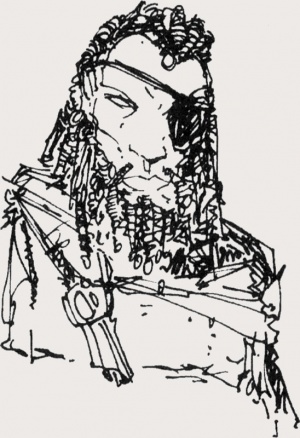
The ship of my passage was captured by pirates calling themselves the "Restless League." They threw over crates from the cargo-hold ~ crates full of arms meant for the Empire at Stros M'kai. And they robbed everyone aboard ~ though their leader, after seeing this, my annotated pamphlet, and guessing my intent let me keep it, telling me "We must not act and speak as if asleep." ~ ??
Tourists have, historically, given wide berth to the Redguard cities outside of those facing the Iliac Bay. Considering the (mostly deserved) reputation of its people, Hammerfell is frequently seen as intolerant of "foreigners," where trespass is dealt with in blood. This is a shame, and a situation that the Emperor seeks to rectify, for Hammerfell itself is a beautiful country. From the twin moonrises over the Alik'r shade-temples to the austere ramparts of Old Hegathe, everywhere there is the appearance of antique splendor. Its people are harsh-- four hundred years of internal conflict and corrupt government have made them so-- but, taken singly, the Redguard is often a masterful work of a man. Perhaps a guiding power like the Empire, steering Hammerfell clear of the foul agents of A'tor's legacy, and protecting her from the avarice of her Elven neighbors (grow weary of pointing these out ~ I trust you will find the rest ~), will bring the same prosperity to her people that it seeks to bring to the world.
Places of Note:
Sentinel
Second capital of Hammerfell, Sentinel sits on the edge of the Iliac Bay. It is most definitely a merchant power, for it sits on a rocky run of hills, and the barren plains behind it offer no good soil before they run into the desert sands of the Alik'r. Its principal street is a vast marketplace stretching from the harbor all the way to the badlands gate. Sentinel Palace is the oldest and largest Redguard architectural monument, quickly built during the Ra Gada firestorm to ward against the Bretons and added to ever thereafter. Currently, this Palace is the headquarters of Provisional Governor Senecus Goddkey, who has been helping to administer the Forebear principalities since Baron Volag's (Rumors persist that this Baron Volag is hiding in the hills with his personal "blood-drinkers", waiting for a sign of weakness in the Empire.) disappearance. Since its Imperial reorganization, Sentinel has become an exotic retreat for the nobility of Daggerfall and Wayrest, who delight in its native cooking, craftsmanship, and the bizarre morality-plays of its Royal Theatre.
Stros M'kai
Formerly the principality of Thassad II's heir, A'tor, Stros M'kai's small island serves as the office of Provisional Governor Amiel Richton, who is charged with the protection and patrol of Hammerfell's barbarous southern coast. Lord-Admiral Richton (Evidently, Richton is breaking down under the pressure of his assignment ~ Stros M'Kai is very important to the Emperor and it is vital that Richton clear its waters of pirates and the sort ~ even the "Restless League" does not realize this (more concerned with sanctity and that mess, I gathered~)) was the officer who defeated Prince A'tor in the Battle of Hunding Bay, and is the latest of a long line of heroes to serve in the Colovian West Navy. Stros M'kai itself would be an unassuming little port, famous only for its Dwemer Ruins, were it not for its presently strategic location near the Cape of the Blue Divide, the waters of the dread Aldmeri Dominion.
The Aldmeri Dominion (of this pamphlete, this regime, this lunacy~) is a relatively recent creation. Formerly divided into the two realms of the Summerset Isles and Valenwood, the Aldmeri Dominion has its origins in CE830, when the heirs of the Camoran Dynasty began to fight over the Valenwood throne. When a faction of the Bosmer (Wood Elves) made overtures of peace to their longtime enemies in West Cyrodiil - territorial concessions in return for Colovian support for the faction's claimant - the Altmer (High Elves) of Summerset invaded the Valenwood Nations. Citing a stewardship clause in a treaty from a thousand years before, the High Elves quickly established a provisional government, the Thalmor, on behalf of their own claimant, Camoran Anaxemes, whose bloodline had struck the pact with the Aldmeri Council in the first place. As the Cyrodilic Empire was still in the shambles of the Interregnum, the Colovians were quickly driven back by the Aldmeri army. The other heirs of the throne were silenced, the Wood Elves thanked their cousins for bringing back stability, and the High Elves reminded Anaxemes the price of Summerset's aid: fifty years' fealty to the King of Alinor. The Aldmeri Dominion was born. (I don't know where to begin pointing out the lies)
The Thalmor strengthened its hold on the Valenwood Nations during the foundation of the Third Empire. Savage Bosmer tribes skirmished with the Estates along the River Strid, whipped to a frenzy by their High Elven masters. With the Empire now reunified under Tiber Septim, these attacks have subsided; but encampments wait on either side of the Valenwood border, awaiting a decisive battle. On the occasions when the Elves probe the Empire's defenses, the Legions have sent them back in tatters. Indeed, the Colovians have taken to calling their enemy the "Old Mary" Dominion, for the womanly offensives of its Elven soldiers. The situation at sea, however, is another story, and the Dominion terrorizes the southern waters from the Cape of the Blue Divide to the Topal Bay. (! ! !) Their sorcery has made allies of a few Reachmen, the Maormer of Pyandonea, and, as of this writing, perhaps even the Elsweyr Confederacy. Though no formal declaration of war has been made, Tamriel is divided between the Empire and the Elder Races, and Tiber Septim has made it known to the Thalmor that he is the True Emperor of Cyrodiil, and heir to all of its former holdings. The Elves of Tamriel have yet to answer.
| The Scarcity of Elven Writings Much of the blame for this can be laid on the Alessian Order, which was tireless in ferreting out and destroying Elven writings during its long dominance. Today, we are left with the beautiful heresies of the Anuad, surviving only by virtue of their popularity and proliferation, and perhaps a dozen more works of lesser reknown. This, though, does not explain fully the scarcity of Elven letters. We might turn to Dylxexes, an early human scholar, for another answer. After studying the financial records of the Direnni Hegemony, a High Elven merchant family that exploited the human kingdoms of its day, he had this to say: "These [records] may help to explain why so much of Aldmeri literature is forbidden, scorned, or untranslated, for I have seen [their] like before. The Direnni were either exceedingly paranoid or their system of economy so inextricably linked with dangerous theosophist numeral-symbolism that much of what is recorded here requires... sorcerous precautions on the part of the reader. [Hidden magic] is everywhere incorporated in their writings... signs and preternatural runes and [correspondences]... in expenditure columns, even, or margins [that] can be fatal to the uninitiated. Crucial pages were covered with the spittle of the previous translator, who had babbled idiotically over the text for days before catching fire." |
Considering we have endured their offenses for two thousand years, we know surprisingly little about the Aldmeri. (Only Morrowind, under Skyrim domination during the First Empire, and open to travel and trade during most of the Common Era, is somewhat better known.). The Elves of High Rock and Cyrodiil were either wiped out long ago or displaced into obscurity. As for the Elves of the Dominion, our knowledge of their regions is limited to brief Imperial occupations, or to the translations we have of their literature (see Sidebar).
| The Great Apes of Valenwood The Great Apes, or Imga, are native beastfolk of Valenwood. They see the High Elves as their lords and masters, and as a portrait of an ideal, civilized society. Great Apes go to desperate measures to emulate the High Elves: they wear capes, practice with the dueling sword, and attempt to speak with perfect enunciation and courtly manners despite their gravelly, baritone voices. Each Imga bears some kind of title, be it Baron, Duke, Earl, or the like, which they use when addressing the members of the Thalmor (needless to say, there are no landowning Great Apes). More extreme Great Apes shave their bodies and powder their skin white to seem more like the High Elves. They often cut themselves in the process, creating the truly pathetic picture of a naked white Ape, skin dotted pink with blood, strutting around the trading posts of Valenwood with mock nobility. The Imga feel that humans are beneath them as lesser beastfolk, and pretend to find their smell exceedingly offensive - a Great Ape holds a perfumed corner of his cape to his nose when Men are around. |
Of particular scarcity is information about either the High Elves or the Summerset Isles. During the Second Empire (My bones chill thinking of such rampant human trespass) ambassadors were allowed only in the capital of Alinor, and thus any description of the Altmeri homeland is confined to that city alone, and elsewhere (see sidebar - Alinor). Furthermore, we can offer only this brief but reliable account of the High Elven people. It comes from the journals of Eric of Guis, Reman's emissary to the Altmer, who (Eric of Guis~ Does Grandfather remember this fool?') lived among them ca. 1E2820:
"High elves consider themselves to be the only perfect race. Over hundreds of generations they have bred themselves into a racially pure line, and are now almost identical to one another in appearance. The theory that the High Elves do not reproduce as quickly or as often as humans is false. Rather, and to my horror, they kill nine out of ten babies born to them in their obsession for purity.
"The Altmer despise other Elves as unsophisticated churls and barely consider the non-Aldmeri races at all. They pay their Imperial tithes, I'm sure, not for fear of war with the humans but rather to keep an invasion from "infecting" their islands.
"Breeding outside the pure line is a terrible, unthinkable crime, and taken as prima facia evidence of the tainted blood of the individual in question- if they were, they wouldn't have the impulse to do it. Exile to the mainland is regarded as equivalent to a death sentence, since there is no purpose in living outside their ideal society.
"They have a high regard for order and gravitate naturally towards wearing uniforms and speaking in formal patterns. Their trees and their livestock have been bred to be as standard and ideal as they are. They have no real names of their own, only combinations of numbers that, when spoken aloud, sound to human ears as such. They feel no real tenderness for one another and have no concept of compassion.
"They are decadent and self-obsessed, and prize form and their own brand of manners or style as their main value. Aware of their aristocratic position, they surround themselves with riches and treasures, the works of great artists and the finest of everything, but have no real appreciation for any of these things. Each of them is concerned solely with himself, and as a result they do no real socializing; they meet and hold courts only to demonstrate their importance and power to each other. Rarely do they speak to the human ambassadors of Cyrodiil; when they do, their speech is full of riddles, or spell-words that enchant one to a satisfied madness."
Valenwood was claimed as a wasteland province of the Second Empire, and its geography is partially described in several Imperial surveys. Valenwood is noteworthy in that it has no cities or townships built by the Wood Elves themselves. Their strict "Green Pact" prohibits the use of wood or other vegetable derivatives as building materials, and they are too improvident to learn the use of stone. The Wood Elves permitted a few roads to be built by the Second Empire, but neglect their maintenance, as the Bosmer do not need roads to move easily through the thickest forest; these roads would be now overgrown were it not for the High Elves of the Thalmor, who have repaired and widened them for rapid passage of their arms to and from the coast. Much of the region is impenetrable mangrove and coastal rain forest, with few grasslands or glade areas until further north near the Strident Coast. Many of the human trading posts established by the Second Empire have been abandoned or claimed by the beastfolk - Centaurs, Orcs, and Imga - that share the forests with the Bosmer tribes. Humans, in general, have learned not to intrude in the forests of Valenwood. While they once depended entirely on the annual Stridmeet caravans of the Colovian West, the Wood Elves now rely entirely on the sea piracy of the Dominion for whatever they require from the outside world.
| Alinor A forbidden city for nearly fifty years, Alinor is both capital of the Summerset Isles and the heart of the Aldmeri Dominion. Human traders were only allowed at its ports, and they described the city as "made from glass or insect wings." Less fantastic accounts come from the Imperial emissaries of the Reman Dynasty, which describe the city as straight and glimmering, "a hypnotic swirl of ramparts and impossibly high towers, designed to catch the light of the sun and break it to its component colors, which lies draped across its stones until you are thankful for nightfall." Falinesti The walking city of the Bosmer king, Falinesti is south in the summer and north come Hearth Fire. It is the largest of Valenwood graht-oaks, whose magic was invoked at the dawn of recorded history. The Camaron throne is somewhere in the highest branches, as are numerous other natural dwellings. Wood Elves climb about its surface like termites, or carefully swing from level to level by means of thorny vines. Humans have generally been too unsettled by the city to stay there long, though Great Apes and Orcs are common. The Thalmor has decided to change the capital of Valenwood from Falinesti to Elden Root for the duration of the Aldmeri Dominion. |
Concerning the Wood Elves as a people, we must again turn to the prolific Eric of Guis. After a grateful dismissal from the Court of Alinor, he stayed with the Bosmer for a time at the capital city of Falinesti, during its summer migration. As the city strode along the coastal region of the Cape, Eric of Guis recorded much about Valenwood culture:
"No less abhorrent are the Bosmer than their kin at Summerset, but they are far more cooperative. The Wood Elves love the current human activity because it makes them feel important.
"They are exclusively and religiously carnivorous. They cannot, or will not, eat anything that is plant-based. They eat game, beastfolk, each other, or meats imported from other regions. This part of the Green Pact is known as the Meat Mandate, and, among its other rules, it requires that a fallen enemy must be eaten completely before three days pass. The family members of the warrior that slew the enemy may help him with his meal. Needless to say, the Wood Elves do not like to engage in large battles if they have not undergone a suitable starvation period.
"Though they are excellent archers, the Green Pact forces their bowyers and fletchers to use bone or similar materials, or to buy bows and arrows from other cultures. The use of woodcrafts created by another race is not forbidden, nor is the sale of their own Valenwood timber as long as it is collected by a non-Bosmeri.
"The Wood Elves, of course, cannot smoke anything of a vegetable nature. Bone pipes are common, however, and are filled with caterpillars or tree grubs.
"For a brief time the Colovian armies used Wood Elf archers, as in the War of Rihad two years past. The Bosmer proved to be too undisciplined and prone to desertion for further use. They would sometimes walk into the shade of a single tree and vanish. Their forest-coupling skills are remarkable. The title of their most famous poem, the Meh Ayleidion, means "The One Thousand Benefits of Hiding."
"At the trading posts of the Empire, the Wood Elves become very happy. Some creations of carpentry delight them to no end. Most of it has never occurred to them. They bring their own trade items: hides, river pearls, finger-bone charms made from the still-magically-charged hands of their dead wizards. They often buy woodcrafts that they have no use for or whose use they never bother to find out. Some of the bravest Wood Elven warriors use wagon wheels as shields, or as (they think) impressive headgear.
"While sometimes amusing, the Bosmer have a bestial side. They can resort to animal shapes if they need to, or water. Their most dreaded transformation is the Wild Hunt, which killed King Borgas for the "iniquities" of his Alessian faith. The Wild Hunt is a pack of shifting forest-demons and animal-gods, thousands strong, which sweeps through the countryside killing everything its path. The Wood Elves do not like to talk about the Hunt, and I gather they do not feel proud of this power at all-Gomini, my Bosmer companion of late, tells me that the Hunt is used for justice, but that also, "every monster in the world that has ever been comes from a previous Hunt. Those Bosmer that go Wild, they do not return.""
The traveler is advised to avoid the lands of the Aldmeri Dominion. Though the Thalmor have representatives at the Imperial City, and the Cyrodilic Grand Vizier Zurin Arctus is meeting with the King of Alinor, contact with the Bosmer and Altmer are often disagreeable to the common Imperial citizen. Avoid their books and magic. Wear the permitted weaponry when near their borders. If you are manly and able, apply for service in the Legions.
Elsweyr is the youngest of the modern regions, and the only one to have established itself in the Common Era, nearly six hundred years ago. It is inhabited by a strange race of intelligent beastmen, who call themselves the khajiit in their native tongue. These khajiit are all feline in aspect, some far more than others. A particular family-tribe, or pride, might include a hunting party of males that appear like upright jaguars, a few beautiful youths who could pass for Elves were it not for their swishing tails, an uncle or two that would stalk the perimeters on all fours, and a chief who, depending on the moons of his birth, might have the form of any of the above. The khajiit attribute their improbable biology to the workings of the ja-Kha'jay (the "Moonstrings," or "Lunar Lattice"), a magical and semi-divine phenomena believed to derive from the influence of Tamriel's twin moons, Masser and Secunda. According to the native tradition, a khajiit born while Masser is full and Secunda a thin crescent will grow to be a cathay-raht, one of the aforementioned jaguar-men, while one born under the opposite conditions will be little more than an intelligent house-cat. Even the Senche-tiger, the largest great cat in existence, has proven to be just another form of the khajiit; these massive beasts can often be found serving as steeds for their more humanoid cousins. Over twenty forms have been documented among the catmen of Elsweyr, and, in their own society at least, no one of them is more important or inherently better than another (with the exception of the Mane form, to be described shortly). However, the ohmes, or "man-faced" khajiit, are those most commonly seen outside of the province, as most adventurers and diplomats come from this, the most discreet of the "breeds."
Until relatively recently, the nearly constant insurrection and tribal warfare among the catmen rarely troubled the stage of history. In CE309, however, Keirgo of Anequina and Eshita of Pellitine combined their long-feuding kingdoms to create Elsweyr, sparking a great class struggle that briefly threatened to draw in outside intervention. Power shifted from two separate kingdoms, each with its own central government and allied tribes, to a nobility besieged by those tribes, who felt that both their ruling classes had betrayed them. Chieftains forgot their ancient sugar-vendettas and signed treaties of their own (recorded, incidentally, through facial tattoos), and before long the cities of former Anequina were under constant attack. Keirgo petitioned the Empire for help, but it had just lost its own ruler, Potentate Versidue-Shaie, and was in similar disarray. When the old capital, Ne Quin-al, fell to the rebels, it seemed Elsweyr would soon burst under the weight of its own union. Peace was restored,however when the normally nonpartisan khajiit spiritual leader, the Mane Rid-T'har-ri'Datta, "bestowed to the classes equality under the bi-lunar shadow, dividing their power in accordance with two-moons-dance of the ja-Kha'jay". What this established, in a more understandable sense, was a rotational power base in which both sides of khajiit society, the city-dwellers under the nobility and the nomadic tribes of the desert chieftains, shared alternate control of the region based on the phases of Masser and Secunda; the terms of this measure, the Riddle-T'har, were overseen by the thinly-veiled dictatorship of the Mane himself. Since then, Elsweyr has withdrew itself into a secrecy that has scarcely been breached in five hundred years.
Geographically, Elsweyr is a harsh area of badlands and dry plains. Only near the southern reaches does the soil turn fertile, and the whole of this region is covered in jungle and rainforests, with sugarcane groves clustering against the two main river basins. The old kingdom of Anequina is its northern section, and has historically offered no threat to either the early Cyro-Nords or the later Cyrodiliic Empires. Indeed, Pelinal Whitestrake, Nibenay warlord of the Elven Pogrom, mistook the khajiit for another strain of Aldmeri and killed many of their number before realizing his error. (!) Human relations have been minimal in the intervening years, but there is talk that the Elsweyr Confedracy has recently struck treaty with the Aldmeri Dominion (see Places of Note: Torval, for more supporting evidence), a situation that, if true, may force the catmen into another bloody confrontation with the Cyrodilic masters of Tamriel.
Understandably, the ja-Kha'jay makes the culture of Elsweyr very strange and alien. It is a peculiar affliction, which seems, at first glance, to be related to lycanthropy. It is not, however, contagious or temporal in effect like the latter- a khajiit retains the form of his birth throughout his lifespan, and the moons, while they determine that form, do not affect it thereafter. There are no known shapeshifting khajiit. On the whole, the catmen of Elsweyr are a bestial lot, victims of their own preternatural anatomies. They are quick to anger, unpredictable, and dangerous, though singly no match for an Imperial legionnaire. It is also worthwhile to point out that the so-called "human" features found among many of the khajiits are, in fact, distinctly Elven in appearance, no doubt proving once and for all the baser predilections of the Elder Race.
This is not to say that Elsweyr is without some semblance of civilization. (!) The khajiit that do walk erect dress and conduct themselves in a close approximation of a modern, human culture. Their dress is an abundant shawl, commonly of brightly patterned cloth, for defense against the harsh sun and saber-cuts. Their chief attire, the budi, or shirt, is fastened in braids down the right side, not permitting any part of the torso fur to be seen, for such is believed to be highly indecorous. Jewelry and trinkets often adorn the costume, and tattoos are very popular. In some quarters, the latter can even have religious and legal significance. A recent trend among the younger ohmes is the application of feline facial tattoos that make them resemble their more hideous and savage brethren. The obvious weapon of choice among the khajiit are their claws, naturally sharp and retractable. Others, though, have mastered the use of the saber and scimitar, the dagger and the longbow. There is no standing army in Elsweyr, and the catmen have never shown an expansionist inclination. In fact, they have lost territory in the last fifty years with the secession of their rim territories (see Rimmen).
| The Mane is no more a "breed" of khajiit than the other, more common forms of the catmen; he is simply unique. Khajiit tradition holds that only one Mane can be alive at any one time; indeed, they believe that there is only one Mane, who is simply reborn in different bodies. Be that as it may, there has been no recorded instance of multiple Manes contending for power; whether this is due to the truth of the khajiit belief, or whether the ruling Mane takes care to eliminate any potential rivals before they can mature, cannot be determined. A Mane can be born only under a rare alignment of Masser and Secunda when, according to legend, a third moon appears in the sky. In olden times, the khajiit would shave off their own manes in deference to the Mane, braiding them into locks that he would incorporate into his own, gigantic mane. Over time, as the population of the region grew, this ritual became impractical. Now, while all khajiit still remove their manes, they do so largely as a symbolic sacrifice. The current Mane still wears the hair-locks and braids of his own tribe as well as those of his Warrior Guard, which encompasses hundreds of khajiit. He is so weighted down by the hair of his kinsmen that he cannot move without aid, and often travels about the countryside by means of a palanquin. |
Tamriel's two moons are inextricably linked to the society of the khajiit, who worship their different phases, and the combination of the phases, as if they were gods. Therefore, each "breed" of khajiit has its own patron deity. Earlier it was believed this practice was just another heathen system of worship common among the beastmen of Tamriel, but recent studies in comparative religion have proven that the lunar gods of Elsweyr are merely the divinities of the Imperial Pantheon (Stendarr, Mara, Kynareth, etc.) in disguise. Similar findings have revealed that the dro-m'Athra, or dark spirits of Elsweyr, which correspond to the inverse phases of Masser and Secunda, to be aspects of the more universal Daedric powers. The khajiit also believe that their gods regularly bestow blessings to their chosen people, in the form of the moon-sugar, a substance native to the Tenmar Forest in southern Elsweyr. This sugar has a variety of uses; it is alternately a seasoning and a magical ingredient, a source of communion with the holy moons and a dangerous and addictive drug. The khajiit understand it to be "crystallized moonlight," caught in the water of the Topal Sea and brought to the sugarcane groves of the Tenmar by the force of the twin tides. By partaking of the sugar, the khajiit believes they are consuming small portions of their gods' eternal souls. This drives them into fits of ecstasy and abandon, and the streets of Elsweyr's major cities are full of catmen shivering in the grip of sugar fits. A particularly hazardous derivative of the moon-sugar, known as skooma, is often smoked in raw form through a water-pipe by the more pathetic khajiit; its victims are addicted for life, and in constant, alternating states of euphoria and lethargy. Nevertheless, moon-sugar is a daily part of khajiit life, and their kingdom's chief export. The food of Elsweyr is invariably sweet; candies, cakes, puddings, and sugarmeats are the staples of the khajiit diet, and travelers to Elsweyr are cautioned against partaking of any of the native food. Humans, it seems, are even more susceptible to the effects of the moon-sugar than the catmen themselves.
Places of Note:
| Torval Torval is the city-state of Elsweyr's spiritual and temporal ruler, the Mane. He and his tribe live here in stately and exotic palaces built from massive timbers of Valenwood oak, whose territorial borders are only a few hundred miles away. Symmetrical sugarcane gardens surround these palaces, where the Mane is often seen in day-long meditations atop his palanquin, held up by his inexhaustible cathay-raht servants. As has been said, the moon-sugar of Elsweyr is the holiest of substances to the khajiit. They speak of sugar as we might speak of the soul or the lifeforce. Therefore, humans have been traditionally forbidden to trespass on these estates, and the Warrior Guard enforce this measure as strictly as they do around the Tenmar Forest. An Imperial diplomat was not long ago chased from the premises, even though he had been promised an audience with the khajiit ruler. The panther-like Warrior Guard hissed at his approach, bared their fangs, and threatened him to leave quickly, lest they "leak his sugar" into the sand. Our Glorious Emperor, Tiber Septim, has yet to seek redress from the lawless catmen. |
Senchal
This infamous city is the largest port in southern Tamriel. Its sprawl covers the easternmost tip of Elsweyr's Quin'rawl peninsula, a motley assortment of bazaars, taverns, merchant quarters, and open-air markets ringed on three sides by its crowded harbors. Senchal is a favorite stopping point for pirates and sea captains seeking to ply illegal or blackmarket goods, it being far easier to smuggle these goods into and out of the Empire by way of the Topal Sea than to use the well-guarded inland highways. Thieves abound here, as do beggars and pathetic khajiit sugar junkies. The traveler is advised to steer clear of Black Keirgo, Senchal's most squalid and dangerous quarter, when visiting the city. Illicit sugar-dens line the streets here, where beastmen and nobility alike wither away in sucrose fevers. All in all, Senchal is the ugliest city outside of Imperial jurisdiction. The air is humid and full of the chimney-smoke caught in the eddies from the surrounding coasts. Much of the city is abandoned or in ruins. In CE560, a strain of the Knahaten Flu blew across the channel from nearby Argonia and quickly infected the city's population. Whole neighborhoods were razed in some mad effort to cleanse Senchal of the Flu and have never been rebuilt. Visitors to the open-air markets can see these charred skylines on the periphery, as black and jagged as the teeth of the nearest sugar junkie, begging for cake.
Rimmen
Though ostensibly its own kingdom, Rimmen still pays tribute to the Mane of Elsweyr, from whose realm it seceded in CE812 during the Interregnum. Earlier, Akaviri refugees had fled persecution when the warlord Attrebus briefly aspired to the Imperial Throne. Attrebus, though he lasted no longer than most of the pretender kings of that period, thought he might rid Cyrodiil of the foreigners who had ruled it for the first half of the Common Era, and he drove the Akaviris past the Empire's borders into Elsweyr. The khajiit granted them asylum in the hills and steppes of northwestern Elsweyr, where they dwelt in relative seclusion until remnants of the Dir-Kamal resurfaced in Cyrodiil, seizing the Throne from Attrebus' successors. The Rimmen (literally, the "Rim Men," as the khajiit called them) joined their brothers to try to rebuild the Empire. This effort was doomed to failure, but not before the khajiit attempted to reclaim their lands in a series of bloody border wars. Currently, since the ascension of Tiber Septim, the hapless Rimmen have once again submitted to the protection of the Mane, with a renewed tribute paying for the Cat Lord's guarantee of their independence, a truly weak reed upon which to lean.
OOnce a part of the First Empire of the Nords, Morrowind is now the land of the Dark Elves, whose origins are shrouded in mystery like the ash storms that regularly blanket their homeland. Savage and proud, the Dark Elves shun all contact with the outside world, even with their brethren from Valenwood and the Summerset Isles. The traveler, upon crossing Shadowgate Pass, may be forgiven for believing that he has left Tamriel and entered a different world. The sky is darkened regularly by furious ash storms belched forth from the mighty Vvardenfell volcano. The familiar flora and fauna of Tamriel is exchanged for bizarre and twisted forms that can survive the regular ashfall. Cloaked and masked Dark Elves tend herds of giant insects. A courier clatters by on the back of a 20-foot-tall, crab like creature. Everywhere, cowering slaves - Argonian, khajiit, human - scurry to carry out the barked commands of their Dark Elven masters.
The grey-skinned red-eyed Dark Elves seem admirably suited to their weird, ash-blighted region. They are known as the Dunmer in the Elven tongue, and now populate the great stretch of northeastern Tamriel between the Velothi Mountains and the sea, and between the southern edge of the Deshaan plain and the northern coast. But from whence these unusual people came, what were their race and lineage, or where their original home, ere they spread themselves over Morrowind and the Deshaan, are questions easier asked than answered. The Dark Elves must have split from the original trunk of the Elven race many long eons ago, for although unquestionably kin to the other Elves of Tamriel, the Dark Elves differ in many ways, not least in their striking appearance. His ash-grey skin and glowing red eyes makes a Dark Elf instantly recognizable, although few have seen one, as they rarely leave their homeland. Like all elves, they tend to be tall and gaunt, but the Dark Elves take the Elvish haughtiness to an extreme, viewing humans as no better than beasts, fit only to serve as slaves on the plantations of Tear.
| The Tribunal The strange heathen religion of the Dark Elves deserves special note. They worship three gods known as "the Tribunal", and believe these gods walk the earth and rule Morrowind directly. To an outsider, the priesthood of the Tribunal seems to be the true power in Morrowind - these Tribunes, if they ever existed, have not been seen in centuries. Each Tribune, who go by the barbaric names of Almalexia, Sotha Sil, and Vivek, has an eponymous city dedicated to its worship, and a palace/temple within each city where the god supposedly resides. The priests of the Tribunal cult are all-powerful in Morrowind; strange processions of fantastically garbed priests roam the land, selecting new candidates to serve the Tribunal, who are seized without resistance and never seen again. |
They consider themselves superior even to other Elves, who in their estimation are effete and decadent specimens of the pure Elven race. (For once I agree with this scribe. The tone of my visit was set at the frontier, when I was questioned by three swaggering chap'thil ~ called me "ill-bred" to my face as if I knew no Dunmeri, and had not even the courtesy to call me by my full name. I held my tongue, under the circumstances ~ I am not as young as I once was, Uncle. ~ But I relish the come-uppance at the hands of the despised humans. Despite everything, I cannot help but to think that a season under human rule would temper Dunmeri arrogance to a most salutary degree ~) The earliest human records bearing on the subject (which must remain our best source until the archives of the High Elves are opened to Imperial scholars) are the sagas and chronicles of the Nords. The Nords gave to the region the name of Dunmereth from being the land of the Dunmer; but in earlier ages it was called by themselves Resdayn; and Imperial Librarian Elba Laskee traces the foundation of the Dark Elven nation back to above 3,500 years from the present time. Morrowind was not given its modern name until after the first eruption of Vvardenfell (see side bar - Vvardenfell).
When first we hear of the Dark Elves, they were divided into numerous petty clans, half of whom were at war with the other half at any given moment. The Nord Sagas speak of Dark Elven warriors pledging themselves to any Nord chieftain who went to war with their clan enemies, a circumstance which undoubtedly facilitated their Conquest by the Nords. The Dark Elves appear in the written record in 1E416, during the War of Succession which destroyed the First Empire of the Nords: "And seeing that the Nords were divided, and weak, the Dunmer took counsel among themselves, and gathered together in their secret places, and plotted against the kinsmen of Borgas, and suddenly arose, and fell upon the Nords, and drove them from the land of Dunmereth with great slaughter." Thus ended the First Empire of men, at the hands of the Dark Elves. It is not for another two centuries that we first hear of the Tribunal, who perhaps arose to prominence in the ruin wrought by the first eruption of Vvardenfell, which laid waste at least half of Morrowind, and led to a permanent shift of population south towards the Deshaan, the broad southern plain which gradually slopes down into the dismal swamps of Black Marsh. Be that as it may, under the Tribunal cult the Dark Elven clans were finally welded into one nation, although clan rivalry remains bitter up to the present day, and the clans cooperate with one another only with reluctance.
Five clans, known as the Great Houses - Indoril, Redoran, Telvani, Dres, and Hlaalu - now entirely control the politics and trade of Morrowind, although in earlier times there appear to have been six. Each major clan is allied with numerous subclans, the alignment of which is more or less permanent, although it is not unheard of for a subclan to switch allegiances. In former times, the clans carried out their feuding with open warfare. This was forbidden under the Tribunal, but the clans still engage in bloody infighting through the unique institution of the Morag Tong, the sanctioned guild of assassins. Clans routinely hire the Morag Tong to eliminate their enemies, and the assassins of the Morag Tong may kill their assigned "marks" with impunity, as long as they conform to the obscure (but strict) rules of their guild. Such an arrangement strikes the citizen of the Empire as an outlandish barbarism, but, as with much in benighted Morrowind, seems well-suited to the savage temperament of the Dark Elves.
Clan Indoril claims kinship with all three of the legendary Tribunes, which doubtless accounts for Indoril's preeminence among the five clans. Indoril's capital is Almalexia, also the capital of Morrowind itself, and the Tribunal priesthood (which is one and the same as the bureaucracy of civil government) is dominated by the Indoril and their subclans. Clan Redoran guards the western flank of Morrowind, and are known as the best warriors among the Dark Elves. Clan Telvani is the most xenophobic of a xenophobic race, shunning all contact with outsiders, preferring to tend their herds of giant insects amid the rocky hills and islands of the extreme northeast. Telvani bug-musk is a highly prized perfume among the Dark Elves, and their riding-insects command the highest prices in the markets of Almalexia and Narsis. Clan Dres rules the southern sweep of Morrowind, where the fertile Deshaan plain merges with the swamps of Black Marsh. The Dres are the great slave-traders and plantation owners of Morrowind. Thousands of wretched captives, mainly Argonians but including not a few khajiits and even Imperial citizens, pass through the infamous slave-pens of Tear, the Dres capital, from whence most find an early death on the plantations which surround that ill-omened city. Clan Hlaalu is the smallest and weakest of the five clans, clinging to Great House status in their ancient capital of Narsis. Traditional enemies of the Indoril, who have controlled the levers of government for 3,000 years, the continued resilience of the Hlaalu must inspire a certain respect. Merchants and traders in a land that despises outsiders, the Hlaalu nevertheless maintain a limited commerce with the Empire, trading stout Imperial broadcloth and Cyrodilic brandy for the elegant trinkets produced by the admittedly skilled craftsmer of Morrowind.
Dark Elven warriors favor a wonderfully light armor made from the carapace of insects, covered over with a finely-woven cloak of spider silk, wrapped several times around the torso. A turban protects the head and face from the ubiquitous ash, with goggles of transparent resin; loose trousers and high boots completes the dress. While this makes for an outlandish appearance, the traveler will understand the utility of these garments the first time he is caught out of doors in one of the frequent ash storms without such protection. When indoors, Dark Elves shed these outer coverings, and luxuriate in a variety of richly-colored fabrics; sashes decorated with clan symbols are common, while cumbersome ceremonial costumes made from various parts of giant insects are the glory of those of the highest rank.
Uncle, what is the last confirmed record of the Tribunal? My tutor always answered my questions about their fate only with "All divine endure". Could Septim be the outsider prophesied by Lorkhan's cult? All signs point to the Tribunal's continued power, although dormant ~
Places of Note:
| Vvardenfell The vast Volcano of Tamriel, this giant mountain dominates the north of Morrowind. It is a small continent all to itself, riven from the rest of Morrowind by the remains of a colossal crater. On a clear day (an exceedingly rare event), the peak can be seen from Almalexia, 250 miles to the south. At the time of the Nord Conquest, a Dwarven kingdom flourished in the north of Morrowind, the region now covered by the Vvardenfell volcano. Indeed, this vanished realm gave its name to the mighty volcano that obliterated it - Vvardenfell is a Dwarven word meaning "City of the Strong Shield". It is not known whether the Dwarves of Vvardenfell were destroyed by the first eruption of the volcano, or whether they had already met the mysterious fate of their brethren across Tamriel (see Marobar Sul's Ancient Tales of the Dwemer for a full discussion of the disappearance of the Dwarves). Certainly, the Kingdom of Vvardenfell remained strong at the time of the Nord Conquest. The doughty Dwarves, secure in their underground fastnesses and united into one polity, were a far more formidable foe than the divided and feuding Dark Elven clans, and remained independent when the rest of Morrowind fell to the Nords. The volcano first erupted in 1E 668; this date, at least, is well attested in the written record. The eruption is still recalled in the tales of numerous peoples - to the Nords it was "The Year of Winter in Summer", to the khajiit, "Sun's Death". Legend attributes its birth to the fall of a god to earth; whatever the cause, Vvardenfell has slumbered uneasily for thousands of years, regularly blanketing the surrounding region with ash. Providentially, the tall mountain range between Morrowind and the rest of Tamriel has served to protect us from the exhalations of Vvardenfell, restricting its ash storms to the land of the Dark Elves, who seem made for life in its shadow. |
Almalexia
The largest and oldest city in Morrowind, named for its patron goddess. Almalexia is truly an ancient city, possibly predating the Dark Elves. It is reputed to be built over the ruins of a vast Dwarven city, although the current inhabitants vigorously deny this. Here the intrepid traveler would find the center of the Tribunal cult, in the sprawling palace/temple of Mournhold, a city within the city. This is also the seat of government of the Dark Elves, where the priests of the Tribunal rule in the name of their legendary deities.
Sotha Sil
Many tales are told of this clockwork city of brass, hidden in the steaming swamps of southern Morrowind, the lair of the most mysterious member of the Tribunal. No reliable reports exist of its location, however, or if this city even exists outside of story and song.
Necrom
"The City of the Dead", Necrom perpetuates a religious tradition that predates the Tribunal cult. From across Morrowind, Dark Elves of every clan bring their dead in solemn processions that can last for months. From the mainland, Necrom, with its lofty walls and white towers, appears to be an immense necropolis, an impression that is strengthened by the constant traffic of corpses across the causeway into the city, a traffic which never ceases, day or night. In fact, the city teems with life: a vast and complex heirarchy of priests and attendants whose sole duty is to prepare the dead for the afterlife and deposit their bodies with the appropriate ritual into the catacombs which honeycomb the rock beneath the city.
Septim is unaccountably in Dwemer artifacts - why? Useful military assets, true, but there is no evidence the Dwemer had much knowledge of magic-resistance ~ Dwemer war machines in our possession provide little more protection from standard transformation and field effects than our best metallurgy ~ What do we have in the archives on the Dwemer of Resdayn? Mechanists may have advanced far with Dunmer help in the years before Vvardenfell ~
Argonie
Ces vastes marais ont fait partie du Second Empire, qui en 1E 2837, s'en est approprié une large portion pour créer la Province Impériale du Marais Noir. La plupart des hommes continuent de nommer ainsi cette région, mais les elfes l'appellent Argonie, d'après quelqu'ancien champ de bataille où nombre de leur ancêtres tombèrent. (Quelqu'un du Thalmor sait de quoi parlent ces humains ?) Ainsi, les natifs de ces marais, une population de tribus animales "d'hommes-lézards", devinrent dans le langage courant, les Argoniens.
Les Argoniens sont rarement vus en dehors de leurs terres natales, à l'exception d'une espèce relativement intelligente nommée les hists. Les individus de cette espèce sont repoussants, mais suffisamment paisibles pour être tolérés dans les royaumes humains, et peuvent être trouvés aussi loin du Marais Noir que peut l'être Lenclume. Le reste des Argoniens sont primitifs, reclus, et pratiquent des rituels païens du culte de la nature qui nécessite la proximité d'une espèce particulière d'arbres à spores, qui ne poussent que dans l'intérieur de leurs marécages natifs.
Le Marais Noir n'a jamais regagné son statut de Province après la dissolution du Second Empire, même si certaines parties de ce dernier restent considérées comme étant des Territoires Impériaux. En ÈC 560 , la Grippe Knahaten s'est propagée tout particulièrement en Argonia, anéantissant la tribu humaine Kothringi, les seuls humains à avoir vécu dans la région sur une longue période. Il a été prouvé que les hists ont été immunisés de cette grippe, ceci mena à la propagation de rumeurs disant qu'en réalité, ils auraient créés la grippe après quelque manipulation de leurs arbres à spores vénérés.
Pyandonea
Far to the south of the Summerset Isles is the island kingdom of Pyandonea, home to the Maormer, a rare breed of tropical elf. It is covered mostly in dense rain forest, and is a playground for the southern water spirits. The Maormer almost never travel to Tamriel or visit their cousins at Summerset, for they were exiled from the latter kingdom in ancient times. They are known to possess a strange, chameleon-like skin, an involuntary process that is similar to the forest-coupling skills of the Bosmer. They also practice a powerful form of snake magic. With this, they have tamed the sea serpents of their island for use as steeds and warbeasts. The Maormer ruler is King Orgnum, a deathless wizard who is said to be the Serpent God of the Satakal (see Hammerfell).
| Collected from the Notes of Bendu Olo, West King of Anvil and Baron-Admiral of the All Flags Navy, and Dealer of Swift Justice to the Foul Spot of Thras. Life Cycle: Juvenile: Disgusting little amorphous grubs. Adolescent: Soft, squishy octopuslike things that cannot emerge on land. Adult: No outside limit to age or size. Individuals seen on land in Tamriel tend to be older, corpulent adults; the trait of greed is common in these individuals, and they excel as merchants and smuggling entrepreneurs. Younger adults lack essential surface survival skills, and are rarely seen on land. Older adults collapse under their own weight unless buoyed by water. Gifts: Perfect memory. They cannot read or write, but they remember everything they see or hear. Magic-adept: All land-traveling Sload know the Recall spell at a high level of skill, and use it casually and frequently as the default mode of travel. It also provides the best defense; they teleport out of difficulty instinctively. We must be on our feet! Liabilities: Poor grasping ability, weak tool use. [Sload slowly adapt their outer integument to conform with surfaces and objects, permitting them to pick things up or climb things like disgusting slugs.] Slow! They think very quickly, but never enough to suit their careful, deliberate personalities. They move slowly, and act slowly. It takes them a long time to come to decisions. They can answer questions quickly, if they choose to… which they seldom do. Cautious. They have no word in their language for adventure. The closest equivalent means 'tragic disaster'. All their heroic myths are about individuals who sit around and think for years and years, consulting cautiously with wise Sload, until finally they act - always deliberately, always successfully. All their mythic villains act quickly, and always fail. Morally Repugnant: Every Sload individual encountered has been a grasping, callous, godless, self-loving schemer. They do not seem to experience or display any familiar human emotions, though they are skilled diplomats and actors, and produce gross, exaggerated parodies of human behavior [laughter at lame jokes, weeping at apparent misfortunes, furious tirades at folly or ineptitude]. They have no compunctions about blasphemy, theft, torture, kidnapping, murder, or genocide. They break laws whenever they calculate it in their best interests. They do not perceive or honor friendship or loyalty in the familiar human terms, except for a cheerful affinity for those who defeat them or trick them in any endeavor. The adult form does not apparently reproduce, and shows no interest in the fate of its offspring. |
Thras
The coral kingdoms of Thras, a set of islands southwest of the Chain in the Abecean Sea, are home to a godless tribe of beastmen called the Sload. These amphibious slugmen, perhaps the most hated race in all of Tamriel, were long thought to be extinct. After the Sload released the Thrassian Plague in 1E2200, which claimed more than half of the continent's population, the largest allied naval force in Tamrielic history sailed to Thras, slaughtered all the Sload they could find, and, with great unknown magicks, sunk their coral kingdoms into the sea.
Sadly, it has been reported that Thras has risen again, and that its masters, the Sload, have recently been seen in various areas of Tamriel. Citizens are encouraged to avoid these beasts, and contact the nearest Imperial authorities when they learn of one's existence. Much is remembered about the slugmen, and has been collected for you in the nearby sidebar. Be vigilant.
Orsinium
Literally, 'Orsinium' means Orc-Town in the early Aldmeris. The goblin-ken (orcs, ogres, gremlins, and other beastfolk) that live in Orsinium favor the Elvish name for their settlement, for it suggests, at least to human ears, a glorious and beautiful fortress-city instead of the squalid and filth-ridden village-and-keep that it is. It was founded during the Camoran Dynasy, when hundreds of beastmen were set free by the rulers of the Summerset Isles and allowed to settle lands north of Valenwood. These Orcish tribes chose an uninhabited mountain region near Old H'roldan in High Rock, for their people were (and most still are) dependent on a rare shaggy giant centipede herdbeast that can live only at high altitudes on alpine and sub-alpine forage.
Orsinium did possess considerable strength during the First Era, when Orcish refugees fleeing the Ra Gada invasion of Hammerfell joined the beastman army already gathering there. This army was determined to take control of the Bjoulsae River and force the kingdom of Wayrest to pay Orsinium regularly for its use. Other powers of the area rose to confront the Orcs, principally the Yokudan Order of Diagna and the chieftan-kings of early Daggerfall. The Siege of Orsinium lasted thirty years and ended in its ruin.
Orsinium briefly became an Imperial territory under the Akaviri Potentate, though this ended with the death of Savirien-Chorak in CE431. The Orcs have recently petitioned the New Emperor to grant them a similar status, but Tiber Septim is famous for his hatred of their kind, and has yet to bestow the beastfolk good answer.
Uncle, do you recall the War this the threes ?

